1lumen selects and reviews products personally. We may earn affiliate commissions through our links, which help support our testing.
FireFlies E07 2021 Edition Review
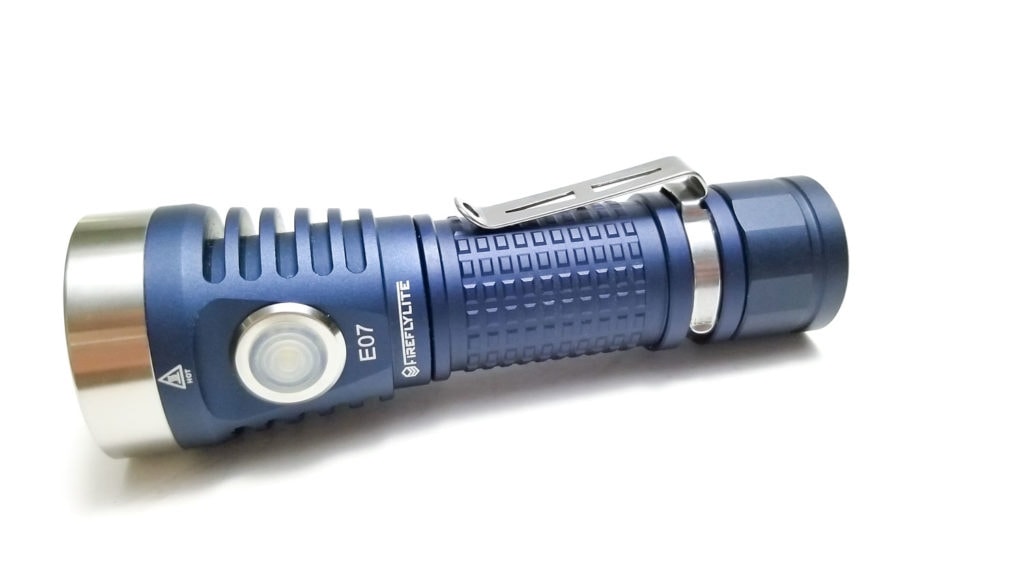
FireFlies E07 2021 Edition specifications
| Brand/model | FireFlies E07 2021 Edition |
|---|---|
| Category | EDC flashlight |
| LED | 7x Cree XP-L HI V2 5A 4000K |
| Lumens | 6,200 lm |
| Beam intensity | 25,000 cd |
| Battery config. | 1*21700 or 1*22430 with short tube |
| Material | Aluminum |
| Modes | Many! Runs Anduril |
| Blinkies | Many! Runs Anduril |
| Reflector | Custom TIR |
| Waterproof | IPX8 |
| Review date | December 2021 |
Introduction:
Note, this flashlight has been replaced. Check out our review of the Fireflylite E07X Canon.
I had to take a step back and reflect on some of the great lights that graced the flashlight community this year, and amongst the big name brands, it was nice to see a number coming out of the FireFlies (or FireFlyLite) camp. In 2021, they rolled out the ice cream cone-shaped T9R, photo light NOV-Mu 21, and bonkers E12R. All great lights with innovative features, a fantastic electronics package, and excellent performance. By now, you’re probably thinking, “Nick. you left out the E07x.” Yep, and that’s because you can’t buy one right now. It’s been perpetually sold out along with the NOV-Mu 21, and E12R, for that matter.
That’s a problem for FireFlies because these were hot sellers with the fantastic Lume1 driver, Anduril2, and onboard charging. I’m sure we can blame the boogie man, MCU shortages, COVID-19, or your in-laws for the shortages, but it left FireFlies with a big hole in their product line and a conundrum on their hands, namely, how to make money selling old lights? Well, they refreshed existing models, adding features like short tubes for 22430 battery compatibility, design improvements, and even mule versions. I reviewed the ‘new’ PL47G2 2021 Edition and sibling PL47G2-Mu mule, and yah, they were different (a bit), but not revolutionary. It was only a matter of time before the regular E07 also went under the knife and was improved. When I was asked to review the “new” E07 2021 Edition, I delightfully obliged, since the E07 is an amazing light and hopefully the improvements have resulted in more than it becoming a placeholder for the flagship E07x (and E12R, and NOV-Mu 21). I hope so because the E07 (especially now) is a pretty important light for FireFlies, so let’s dig in.
Package quality.
The FireFlies E07 2021 Edition came in a nice, premium-looking package. It’s identical to the PL47 boxes, and it’s not really retail friendly since the outside of the box is pretty spartan. On the outside, it’s the brand name FireFlyLite and a sticker on one end with the build date, emitter type, body color and a quality inspector mark. Like the PL47 lights I reviewed earlier, the E07 review light came fully kitted-out with optional extras. The light itself was nestled in dense foam in the box, with the accessories sitting in their own cutouts or riding on top in a baggie.
- FireFlies E07 v2021
- Optional 22430 tube (installed)
- 4 spare o-rings (2 for the short and 2 for the 21700 tube)
- 22430 size li-ion cell (installed in the light)
- UI manual
- Pocket clip
- Lanyard with quick-release clip
- 21700 tube
- Extra tailcap for long 27100 cells
This is a really nice assortment of accessories, and the optional extras are a very nice addition. Depending on how you bundle this (with short tube+battery or 21700 tube, with or without battery), you get everything you need. Further evidence of their E07X dilemma is evidenced by the inclusion of an extra tailcap. It’s missing the PCB and tailspring and is supposed to enable the E07 to accept 21700s with integrated charging. The accessories (minus the tailcap) seem to have been lifted from the PL47G2s since the junky, ends-melted-together lanyard is still present. I was hoping they would have thrown in a nicer lanyard, but oh well. Kind of a brown stain on the nice white sheets. The 22430 cell was properly discharged to 3.7 volts as well for storage.
Note: the FireFlies E07 is discontinued, and replaced by the E07X, and onward. I would highly recommend checking out the following lists instead:
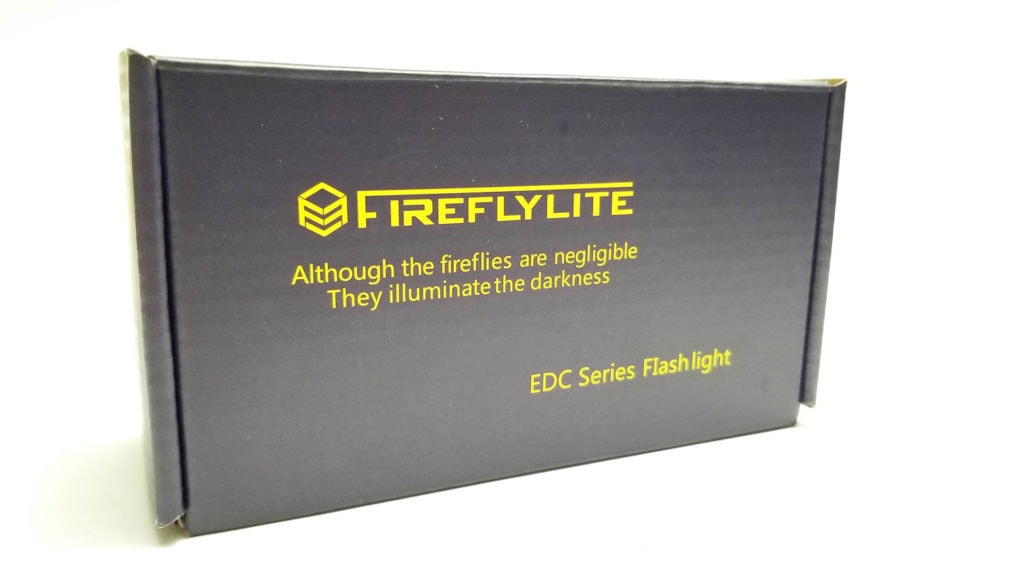
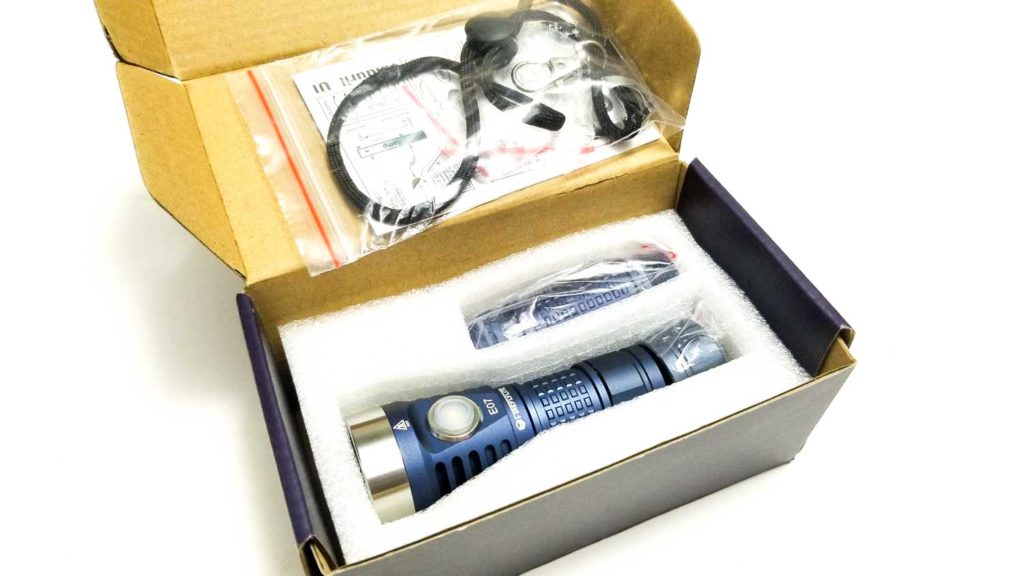
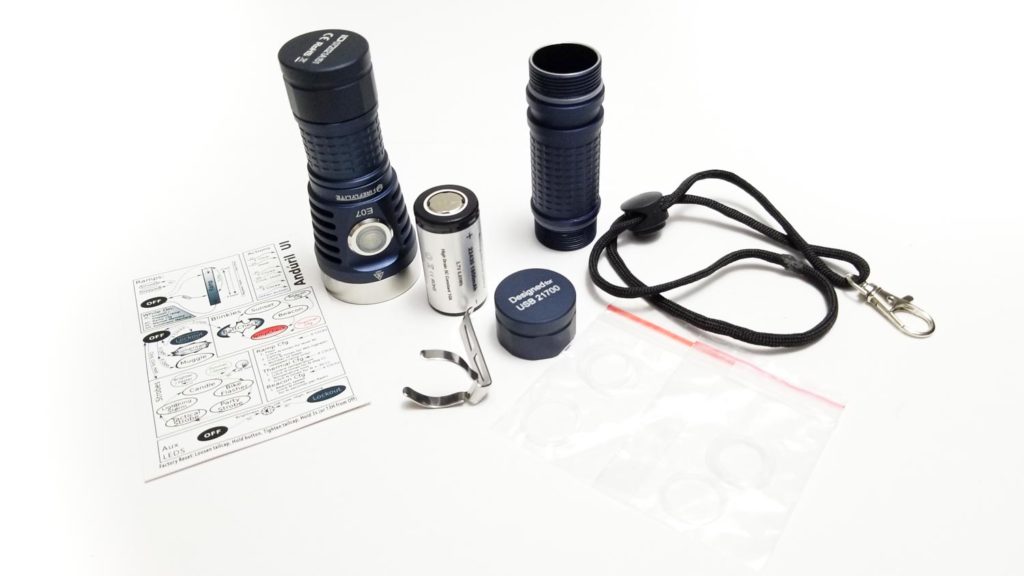
Flashlight in use
As flashlights go, I must say the E07 is beautiful. It’s a 21700 size form factor, but the 22430 size tube was an addition for the 2021 refresh. I loved how the light felt in my hand with the 21700 size tube since it’s nicely-proportioned and the balance is pretty neutral with the center of gravity coming in behind the switch. It has the right amount of heft to it also, and didn’t feel cheap. The hand grenade texture on the tubes made for an excellent gripping surface. Surprisingly, with the 22430 size tube installed, the handling isn’t disrupted too badly, and the balance is still good. Although it becomes a little ungainly in my large hands with the short tube, it wasn’t awkward or clumsy to maneuver.
The head has 5 deep heat sinking fins culminating at a pretty thick 10 mm MCPCB shelf for good heat sinking. The tailcap has flats machined in for grip and provides enough grip to be useful. The e-switch is mounted in the middle of the head and I had no trouble reaching it from all grip angles. The click action is very good, with slightly soft, but positive clicks with good feedback and feel. It’s mounted in a flat spot in the heat sink fins surrounded by a raised polished stainless steel bezel (which accentuates the polished stainless head bezel), backlit by 4 white SMD LEDs. When the light is off, all 4 are illuminated, but when on, only 2 are illuminated.
The 21700 tube has a very deep groove milled in for the pocket clip, which can be mounted for bezel up or down pocket carry or clipping to clothing or gear. However, the part that clips to the body seemed too small, and when I tried mounting it, I had to apply a lot of force. FireFlies does recommend adding some lube to the groove before installing the clip, and I dabbed on some SuperLube and that helped. The 22430 tube has no groove so you can’t use it with the clip. There are a couple options for mounting the lanyard, and if you forgo using the pocket clip as an attachment point, you can thread it through a cleverly-positioned lanyard hole integrated in the heat sink fins under the switch. It’s a properly-sized lanyard hole, but I didn’t find myself using it much. I tried it with the included lanyard, but the clip wouldn’t sit flat with the body and stuck out, which made it a bit awkward.
Like the PL47G2, the E07 has a stout magnet in the tailcap. It’s pretty strong (seems stronger than the one on the PL47s) and grips the battery to pull it out of the tube, as well as holding the top heavy light at a 90 degree angle with good stability. Although I am usually NOT a fan of magnetic tailcaps on EDC lights since they tend to gather up anything metal that finds their way in my pocket or pull my pants outward if standing too close to a metal object (check stand, ATM, etc.), I am really digging the usefulness it adds to the E07, especially when you need your hands free. Tail standing is delightfully stable, but without the pocket clip, it rolls on down the road with aplomb.
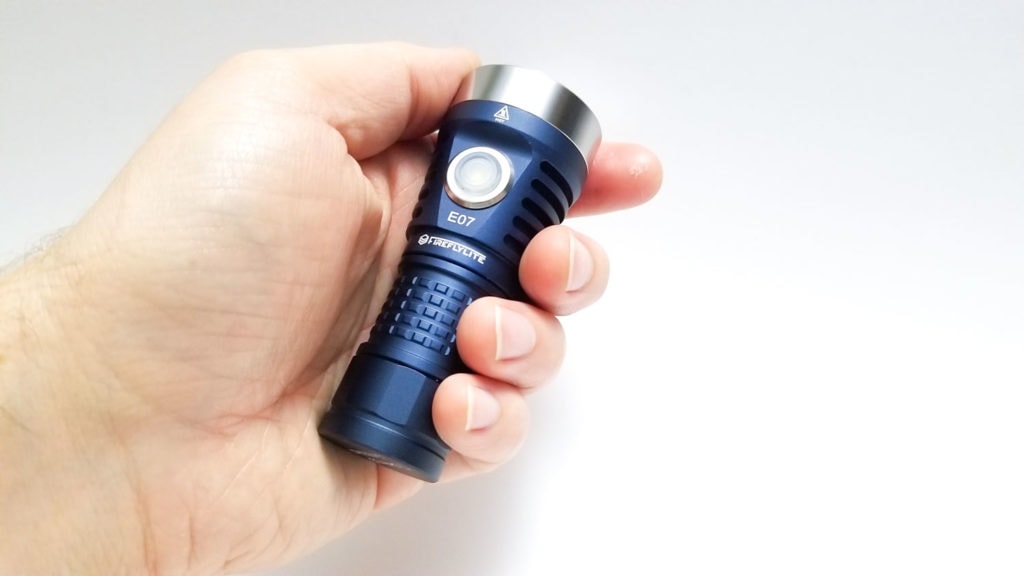
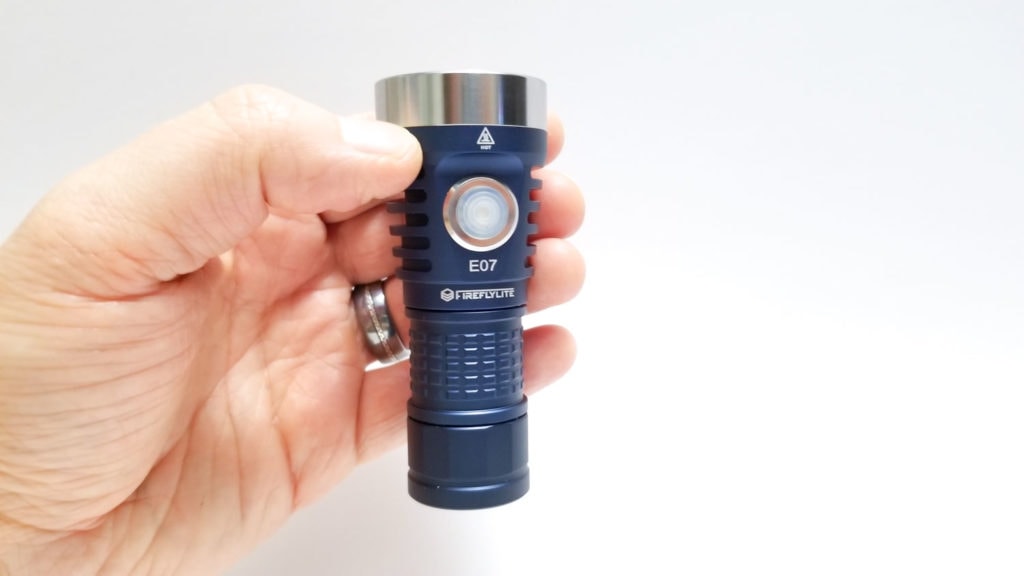
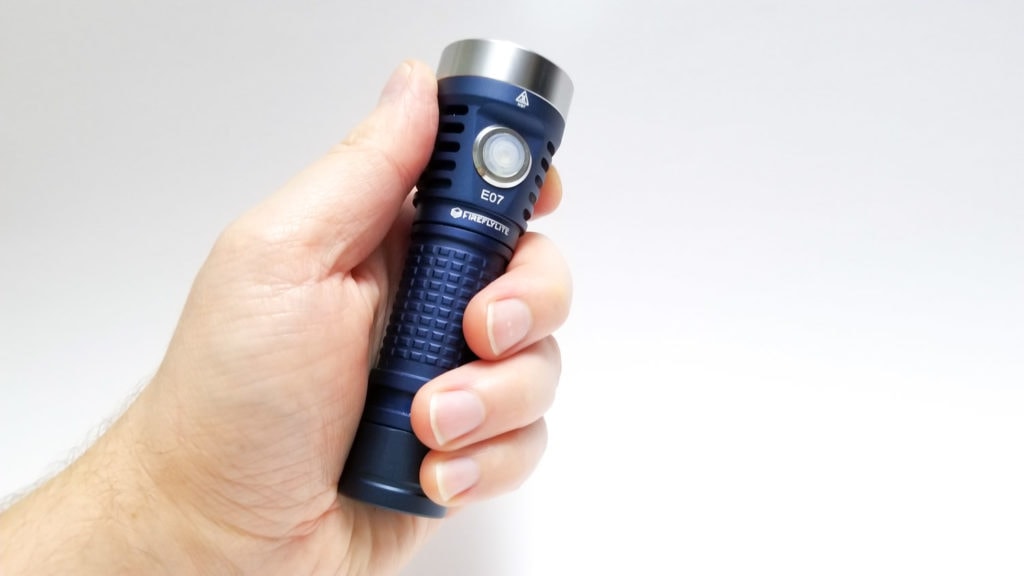
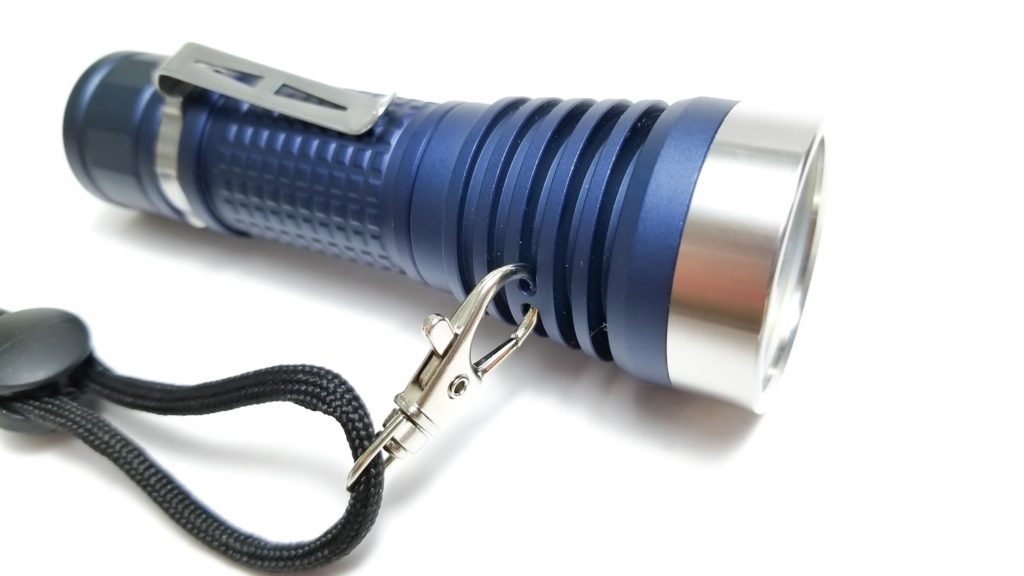
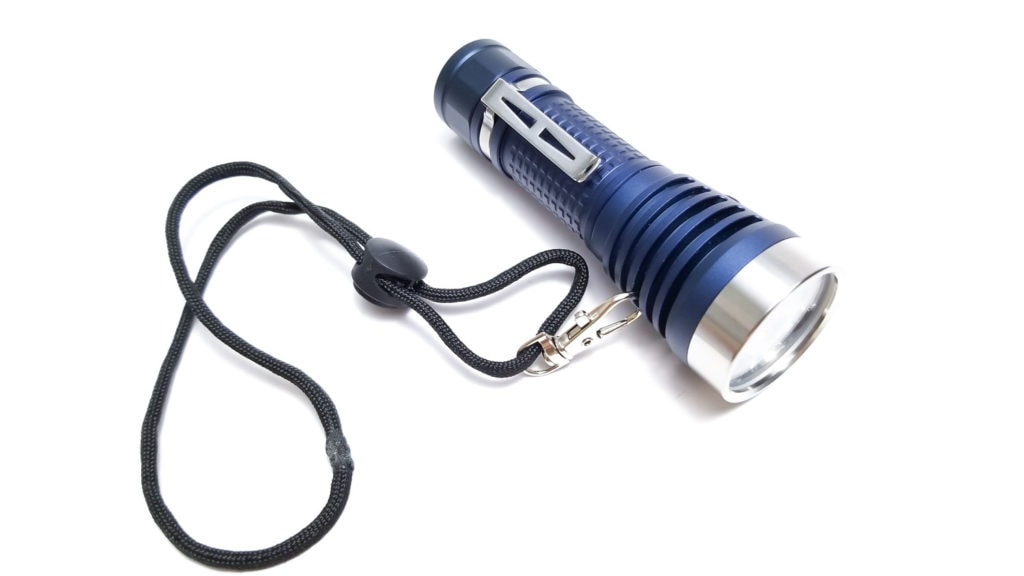
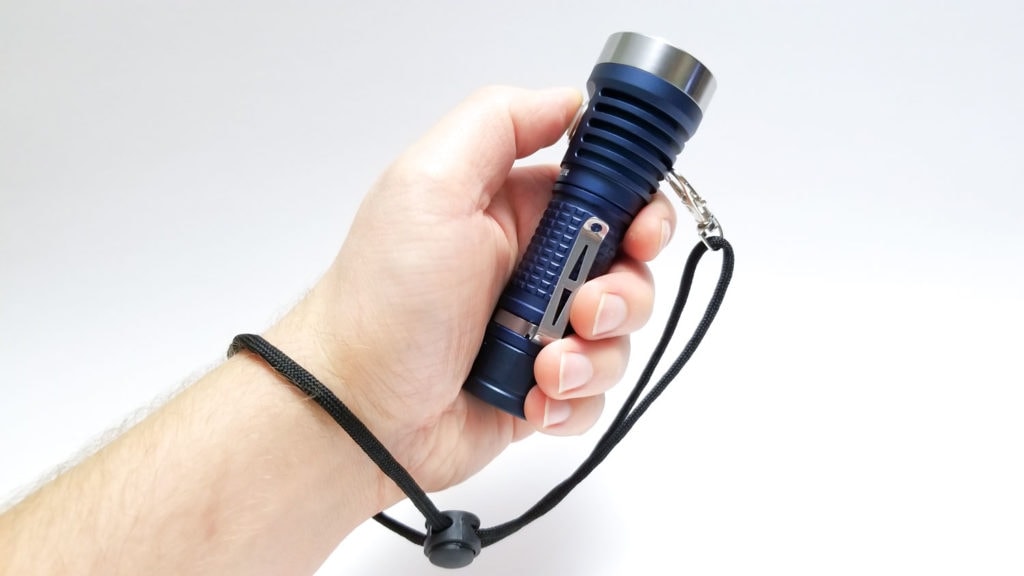
Build Quality, and Warranty
Okay folks, let’s talk about the price because FireFlies had to get clever with the pricing to undercut the E07x Pro enough to make it a viable alternative to the E07x. I think they’ve done that, at least to a point. The E07 2021 Edition starts at $65.00 US, and that’s a good deal, but when fully kitted out with optional emitters (SST20’s and the Nichia 219B come stock, but XP-L and OSRAMs are $25 and $30 extra, respectively), special tailcap, short tube and 22430 battery, the price jumps to over $100. That’s an issue since the E07x starts at $98.00, so unless you’re okay with the stock emitters, it’s almost worth it to wait for the E07x to come back in stock.
Unfortunately, we can’t talk about FireFlies without airing out their dirty laundry because they’ve had a bit of a rough go with quality control in the past. Although I haven’t encountered any of the major quality issues like missing thermal paste, poor machining and finishing, parts that don’t fit right, and galled threads, I can’t say they have been completely trouble-free. The main issue I experienced is the tailcaps (including the ‘special one’) seem to be a darker shade of blue than the rest of the light, almost like a poorly-executed paint job on a car. It’s not the end of the world, but it makes the light look weird under certain lighting with an off-color part and is a bit unacceptable. Even my Convoys, Astroluxes and Sofirns don’t have this issue. Just saying.
The fit and finish? Aside from the color SNAFU, the build quality is superb. The body is made from 6063 aluminum alloy, and that’s good because compared to 6061 alloy, 6063 takes a nicer surface finish, has superior heat capacity and electrical conductivity properties, and is more corrosion-resistant. When properly heat-treated, it’s also tougher and more durable than 6061 aluminum. The finish is easily as good as my Acebeam, Fenix, and Cyansky lights. I couldn’t see any tool or machine marks, chips, or blemishes, and all the parts fit together fine with no abnormal gaps and no sharp or abrupt edges. The build and finish quality is even better than the PL47s I reviewed.
You can get the E07 2021 Edition in type IIIHA desert tan, navy blue, or red (non-HA) anodizing. My sample came in the navy blue color, and It’s a nicely matte, very grippy finish comparable to any Acebeam or Convoy finishes. I was able to unscrew the bezel by hand to expose the custom-designed TIR, mineral glass lens, and way-cool-looking aux LED board and MCPCB arrangement (the aux LED board sits on top of the MCPCB). There is an o-ring sealing the bezel, and thick o-rings sealing both ends of the 21700 and 22430 tubes. With no external charging port, FireFlies believes this is good enough for a generic IPX8 rating.
The threads are fully anodized and decently-sized square-cut on the tailcap side and a bit finer triangular cut on the driver-side. The small-ish triangular threads were still adequately sized, but I think square cut threads are a better choice. They were also llloooonnnng and it took 8 full turns to tighten the head to the battery tube! The 22430 tube didn’t have any lube that I could see, but the 21700 tube did have some thick grease. I ended up adding some SuperLube synthetic grease for maximum smoothness. The springs on the tailcap and driver are high current BeCu, so that’s a nice touch and attention to detail for max current flow. Although a bit overkill, the driver spring was also bypassed with an 18 gauge wire direct to the LED positive terminal. The soldering looks just fine as well.
FireFlies warranty is still plenty good, but your mileage might vary in terms of ease of any warranty considerations since it’s highly dependent on where/who you bought it from. From the website: “We provide 3 years’ manufacturer warranty to fireflies flashlights. (Consumable batteries are not in warranty). DOA products can be returned and refunded within 15 days, We will bear all the returning shipping cost.”
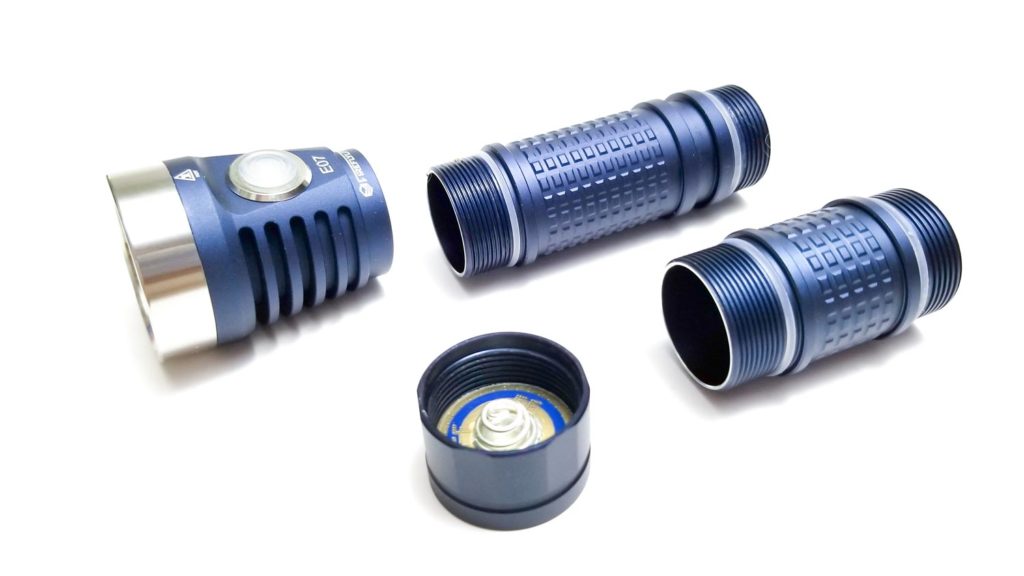
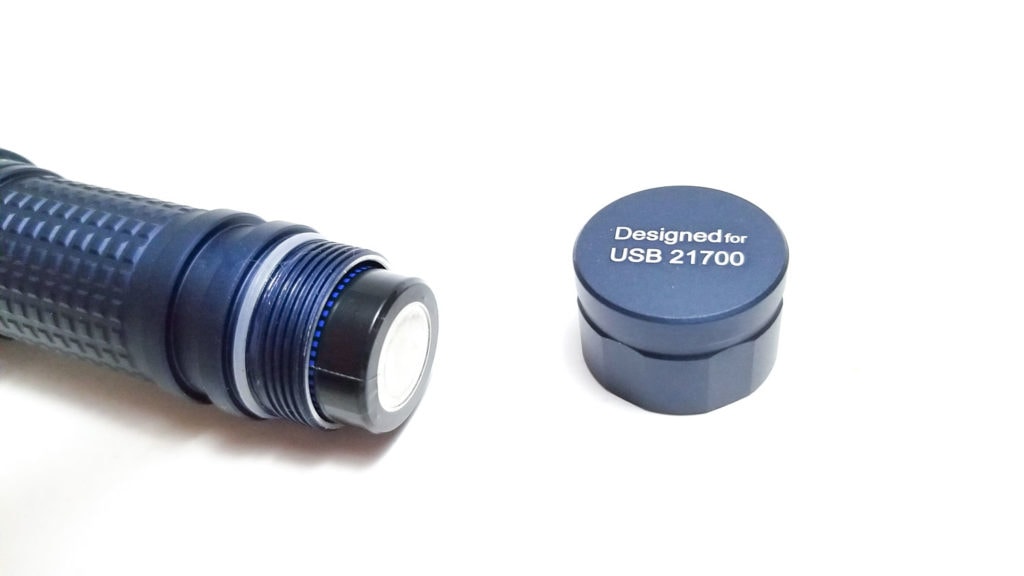
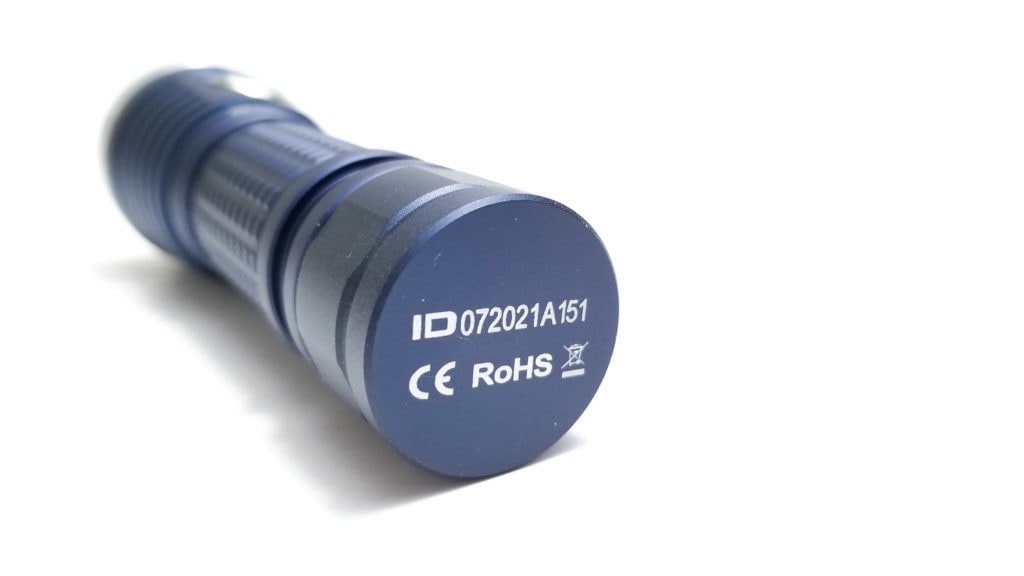
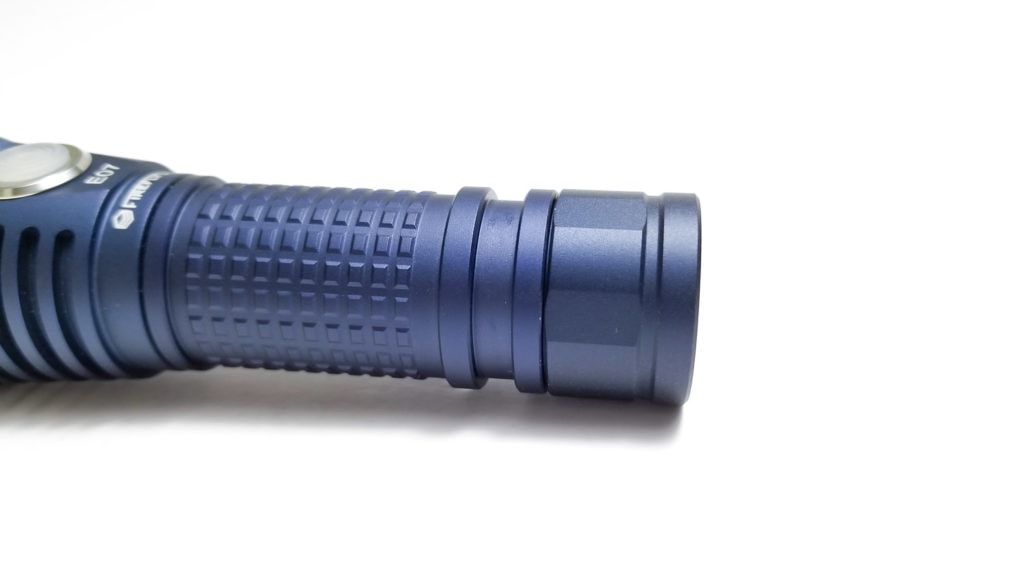
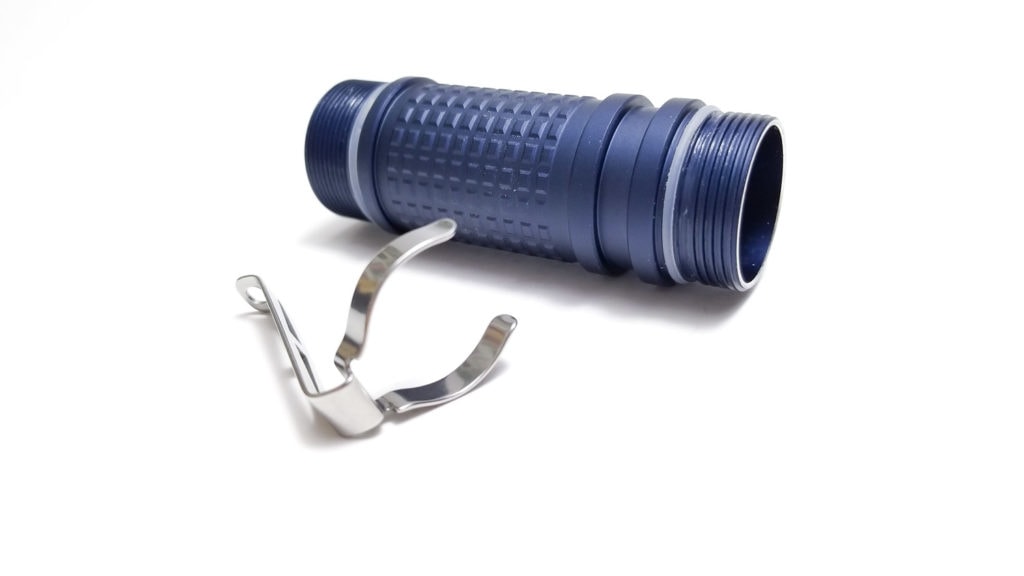
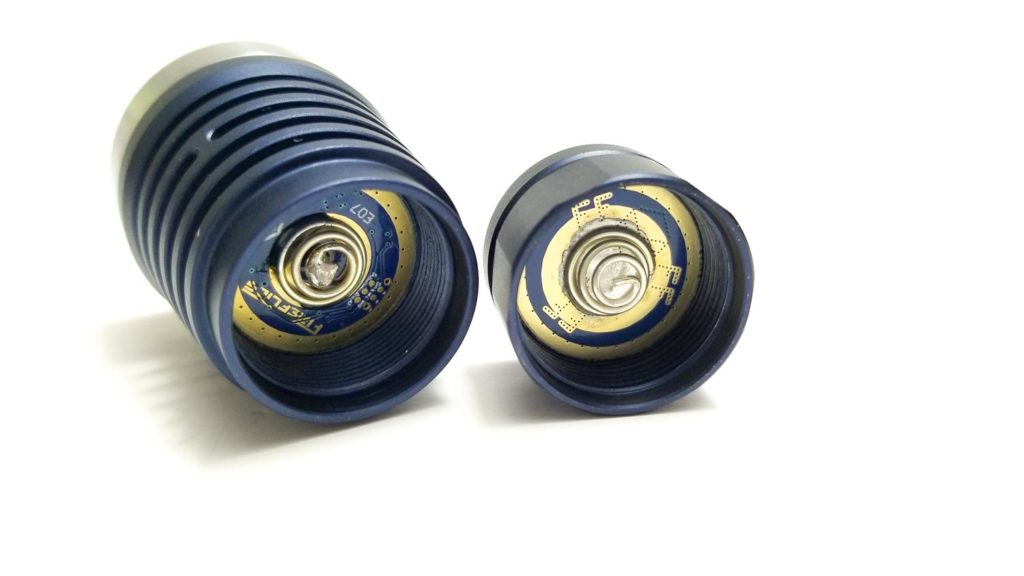
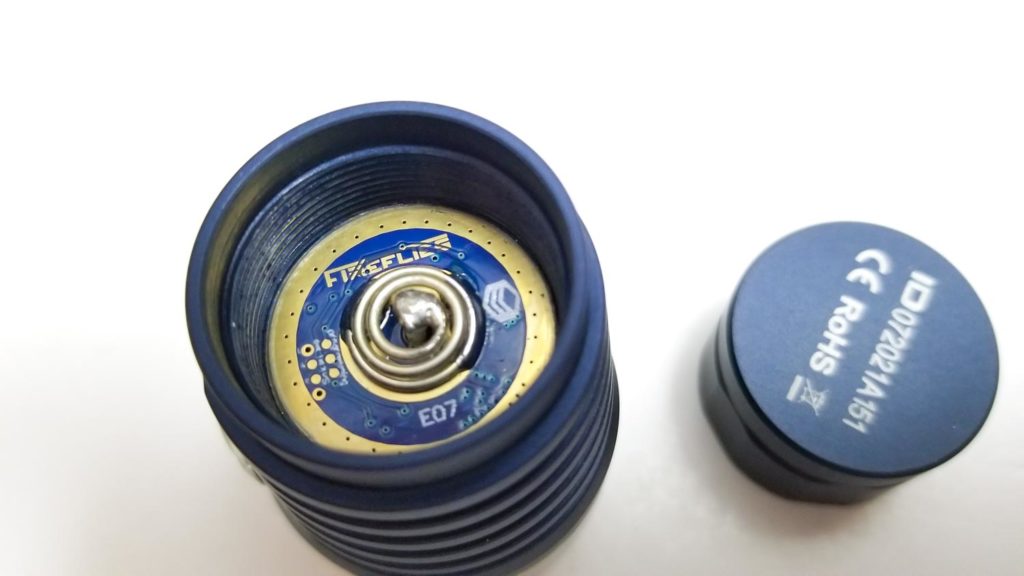
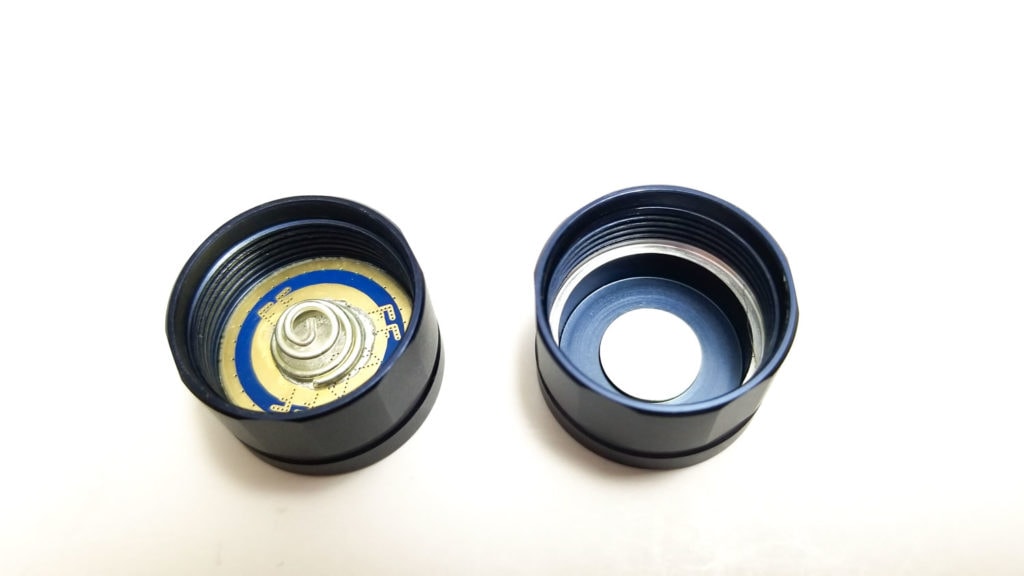
LED, Lens, Bezel, and Reflector
The 2021 Edition E07 is unchanged from the prior version and features a 7 LED configuration under a custom TIR lens. Like other FireFlies lights, the LED selection is very comprehensive and consists of popular enthusiast LED choices including the tint-snobberific Nichia 219B SW45K D220 9080 as well as the Luminus SST20 and Cree XP-L HI in 4000, 5000, and 6500K. Although availability varies, as of this writing, available choices include the 219B SW40 D220, Luminus SST20 FA4 in 4000K 95 CRI, L5 DA 5000K, or L5 6500K, and for Cree offerings, the XP-L HI in V3 1A 6500K or V2 5A 4000K. FireFlies also added the OSRAM CSLNM1.TG (1mm2) emitter for those wanting more throw (up to 60,000 cd advertised). The LEDs are mounted to a custom MCPCB topped with a second PCB housing the ice blue aux LEDs.
The main difference is a switch to a 20 degree beam angle vs. the original’s 25 degree and E07x 10 degree. This should lend itself to adequate throw and good side illumination. Keep in mind, different emitters will have more (SST20, Osram, or XP-L HI) or less (219B) throw. The TIR is protected with an AR coated mineral glass lens that FireFlies says is good for 98% light transmission, surrounded by a finely finished 304 stainless steel bezel. The lens is set back about 3.5 mm from the bezel edge, and this should do a good job protecting the lens (and it looks amazing with the navy blue finish). The beam? You get a nicely defined, albeit very large and diffused hotspot with abundant side illumination. The throw is adequate for a multi-emitter TIR, and it’s about perfect for EDC or general purpose use. Although I prefer a bit cooler neutral CCT, (around 4000K and 80 CRI on the Opple Lightmaster 3), the warm-to-neutral white color of the V2 5A emitters makes for a pleasant beam indeed, with none of the green tint of the cooler/neutral SST20.
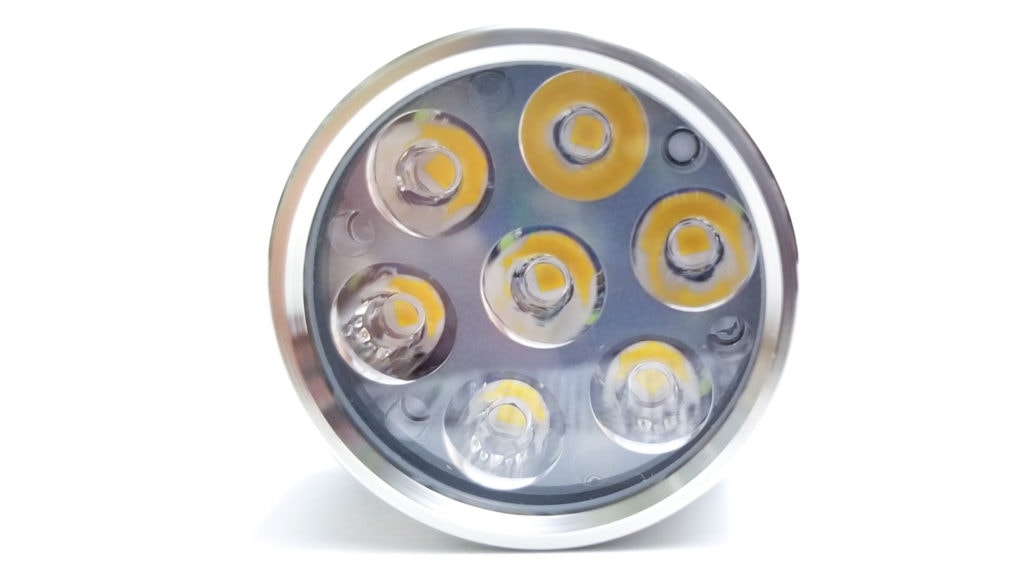
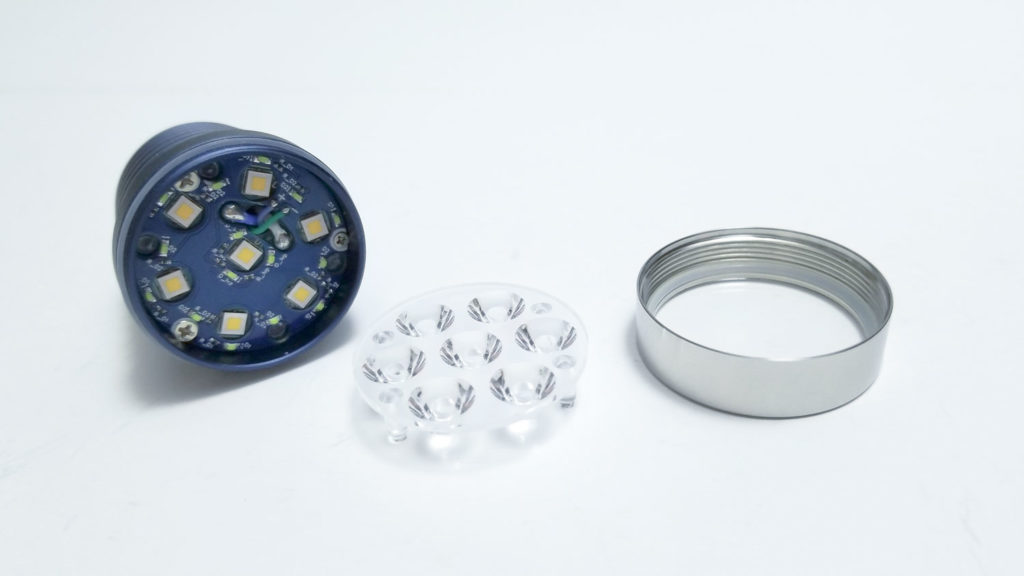
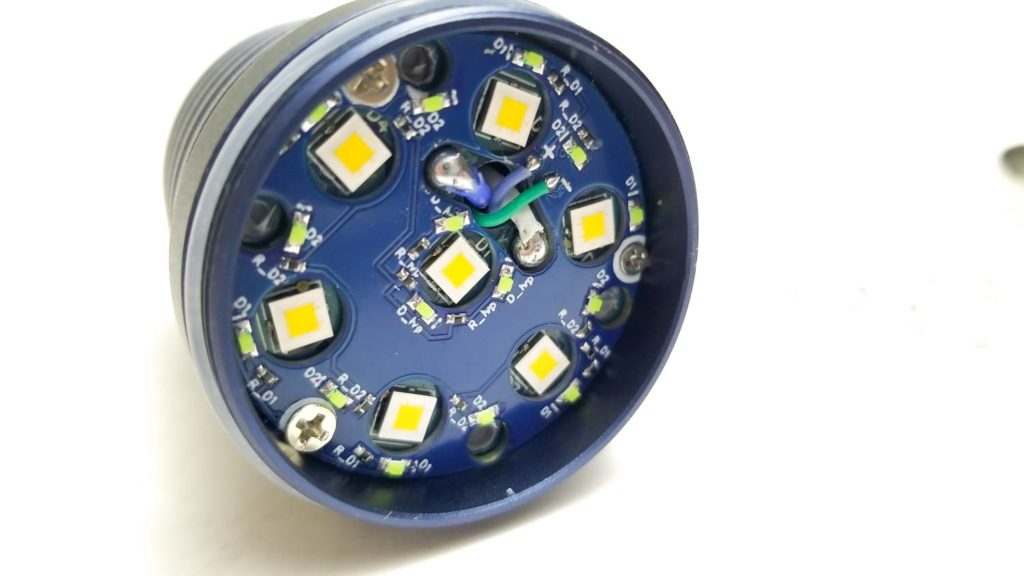
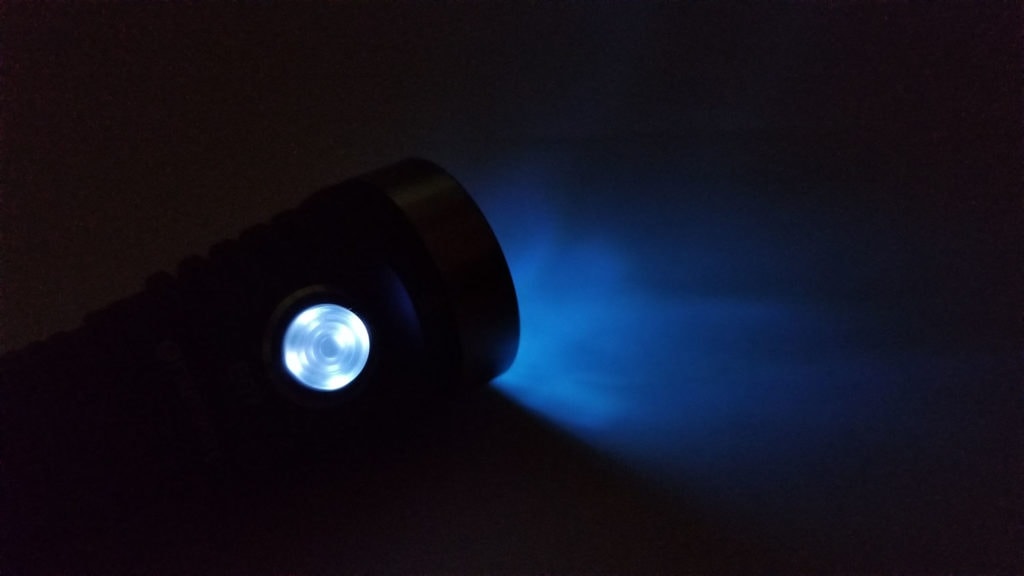
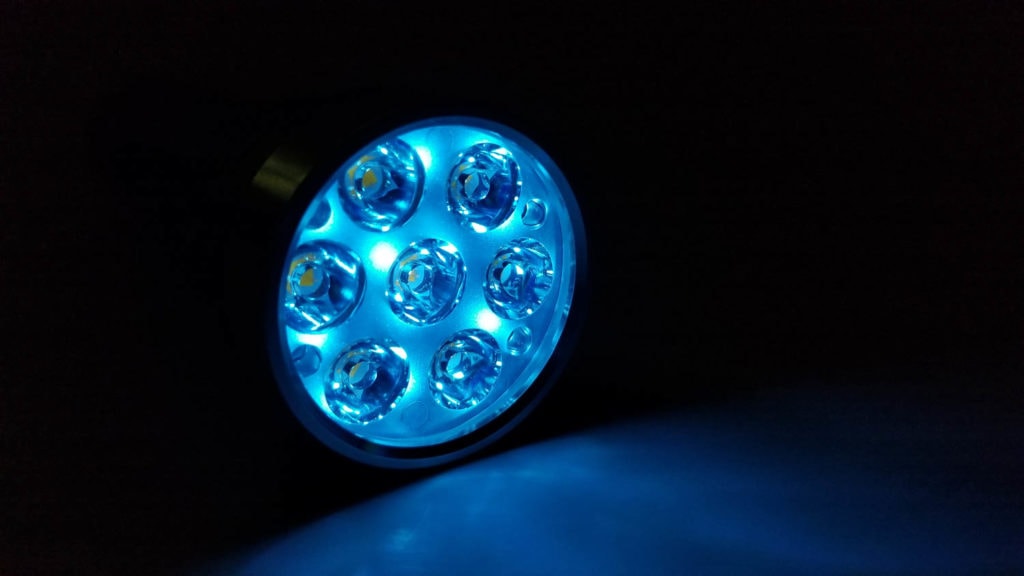
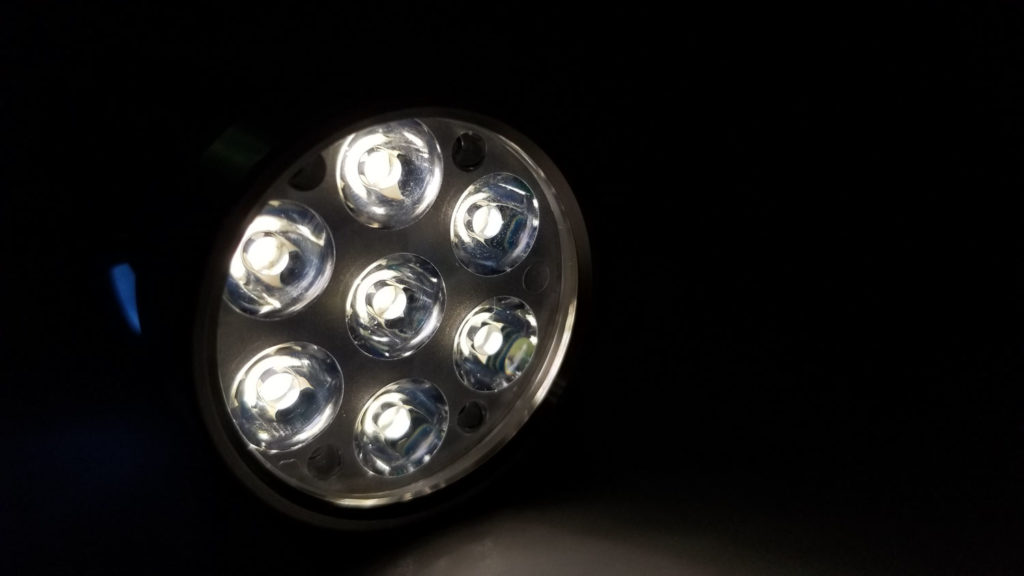
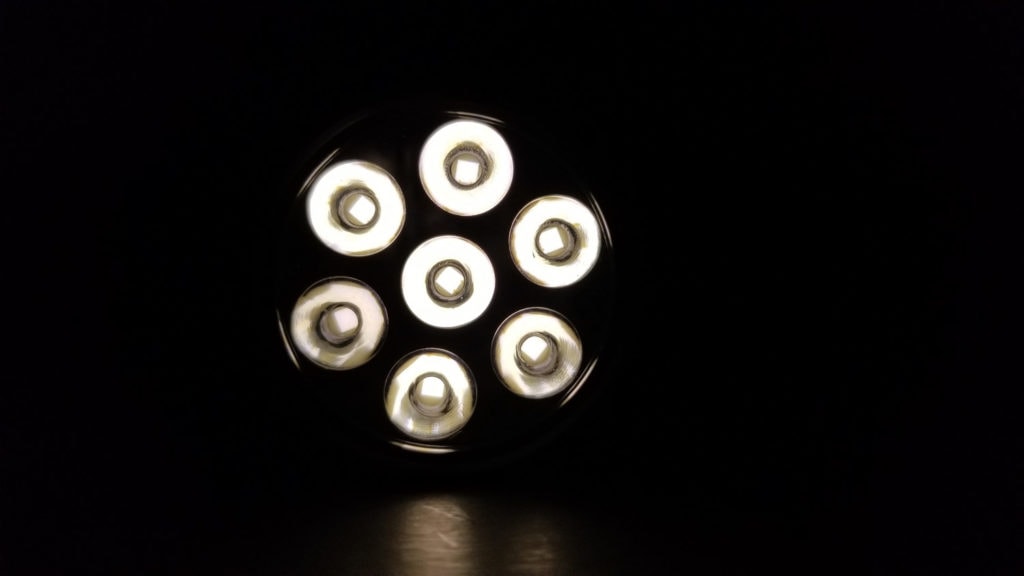
Dimensions and size comparison
- Length with 21700 tube: 8.9 cm / 3.14 inches. With 22430 tube: 6.45 cm / 2.53 inches
- Height: 3.4 cm / 1.33 inches
- Width (body): 2.8 cm / 1.10 inches
Weight:
- 22430 tube without battery: 66 grams / 2.32 oz.
- 22430 tube with included 1850 mAh battery: 107.5 grams / 3.79 oz.
- 21700 tube with Epoch 50G 21700: 141.8 grams / 5.0 oz.
- 21700 tube without battery: 72.7 grams / 2.56 oz.
EDC Flashlight comparison
Compared the E07 to some other general purpose and high power EDC lights.
Group 1 left to right: WildTrail WT3M, Thrunite TC20 V2, FireFlies E07 2021, Imalent R30C.
Group 2 left to right short tubes: FireFlies PL47-MU, FireFlies E07 2021, Astrolux EA01.
Group 3 (from the front) left to right: WildTrail WT3M, Thrunite TC20 V2, FireFlies E07 2021, Imalent R30C.
Group 4: Thorfire C8, FireFlies E07 2021, and the tiny Cyansky M2
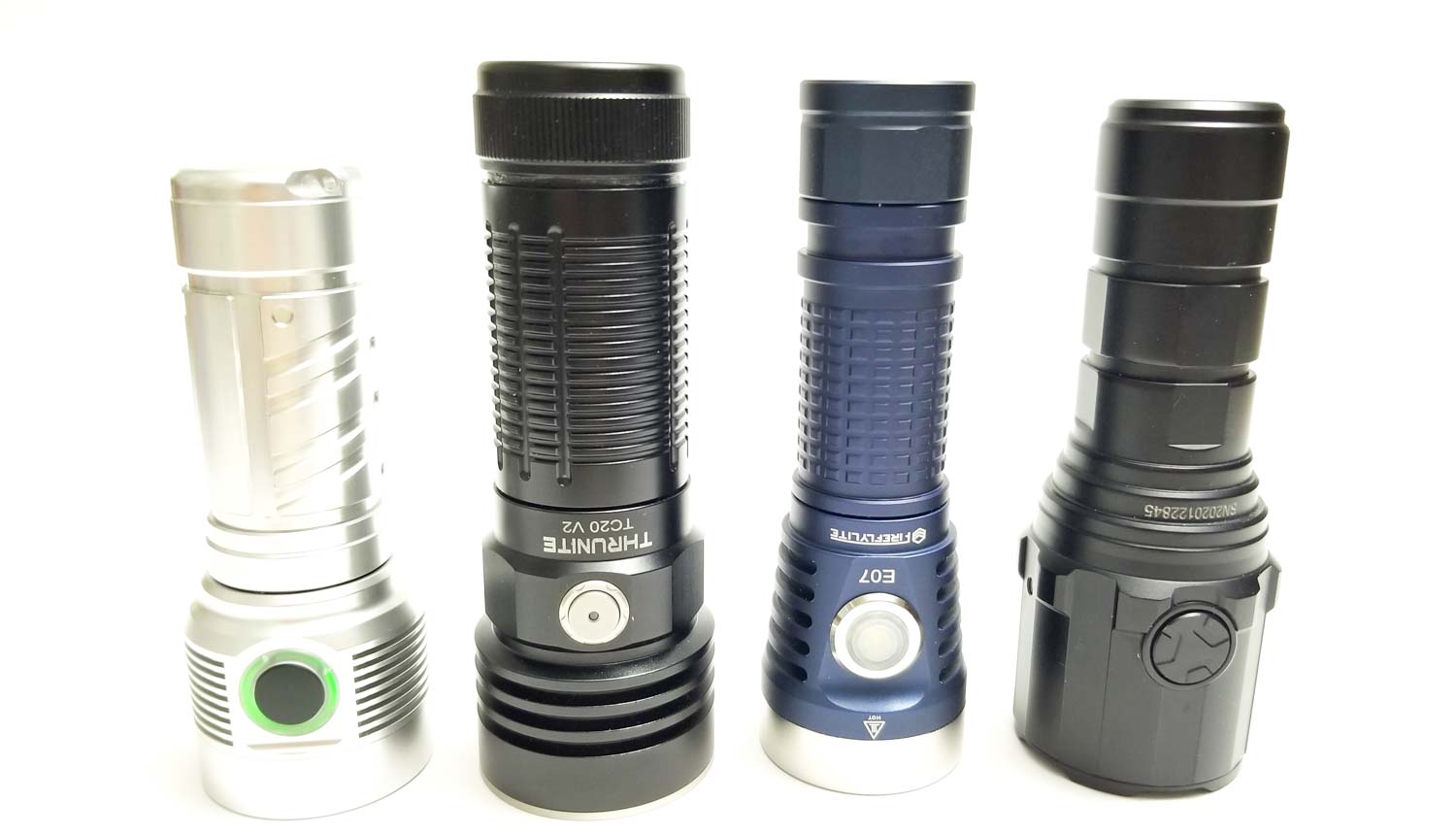
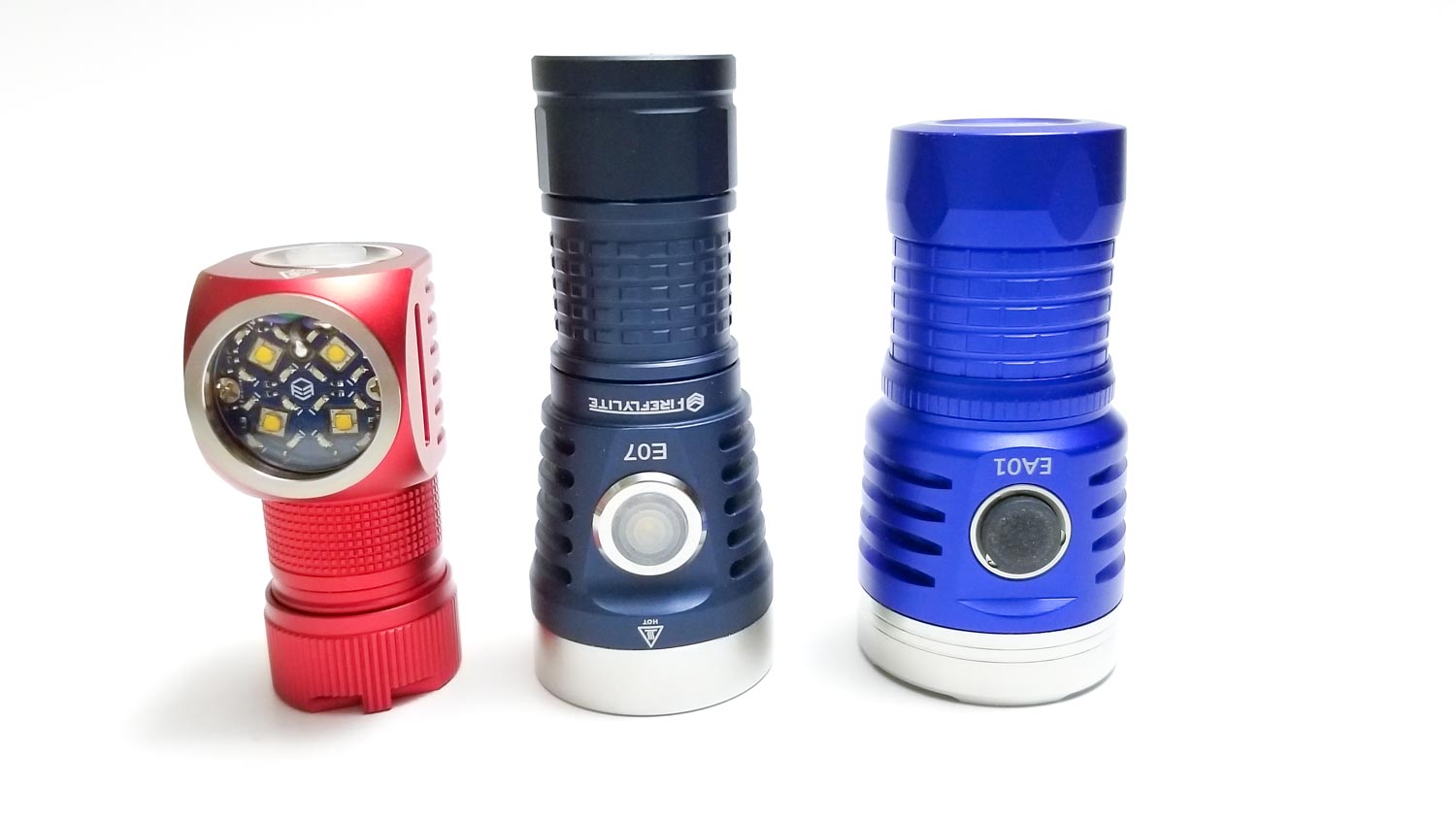
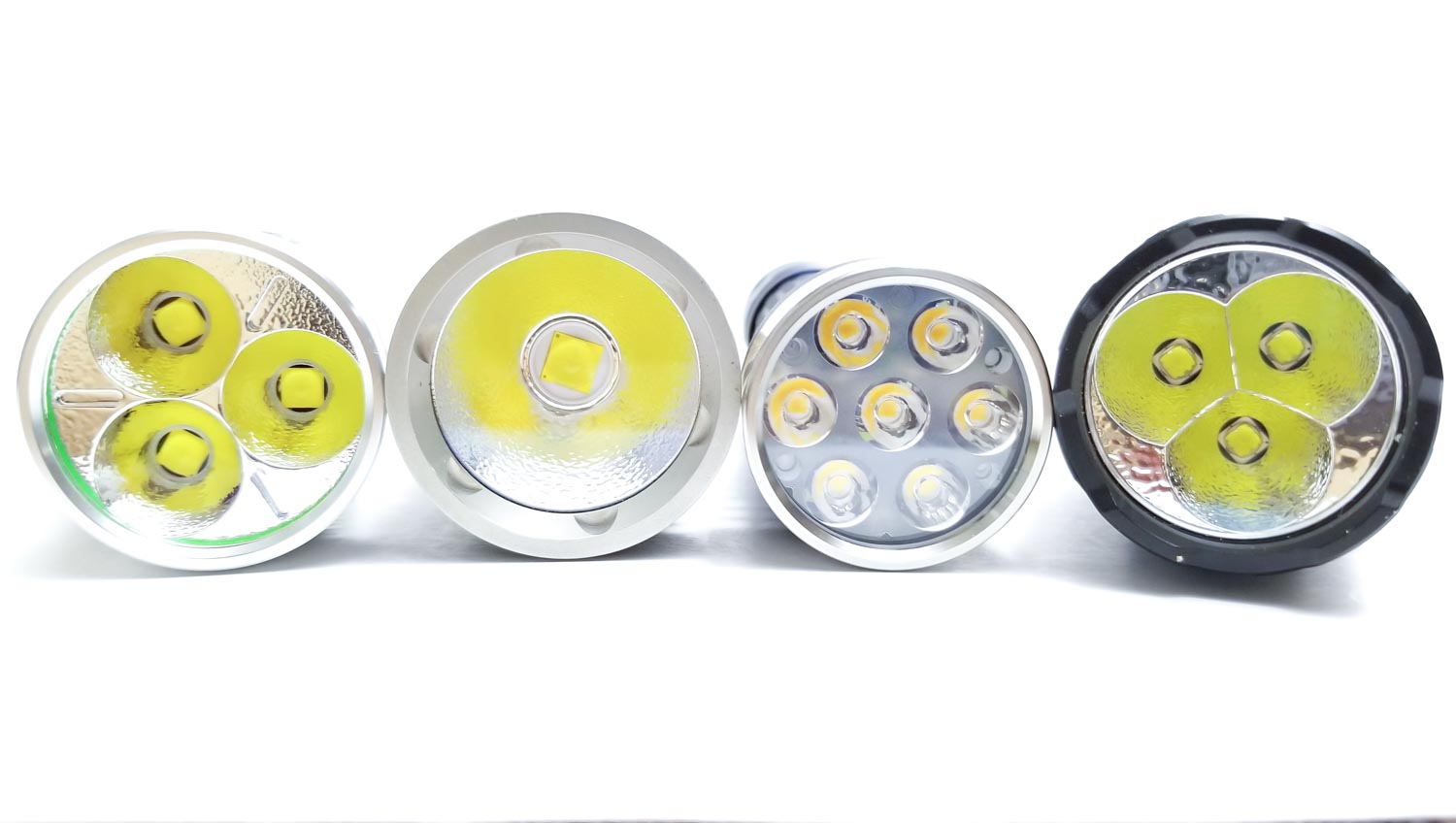
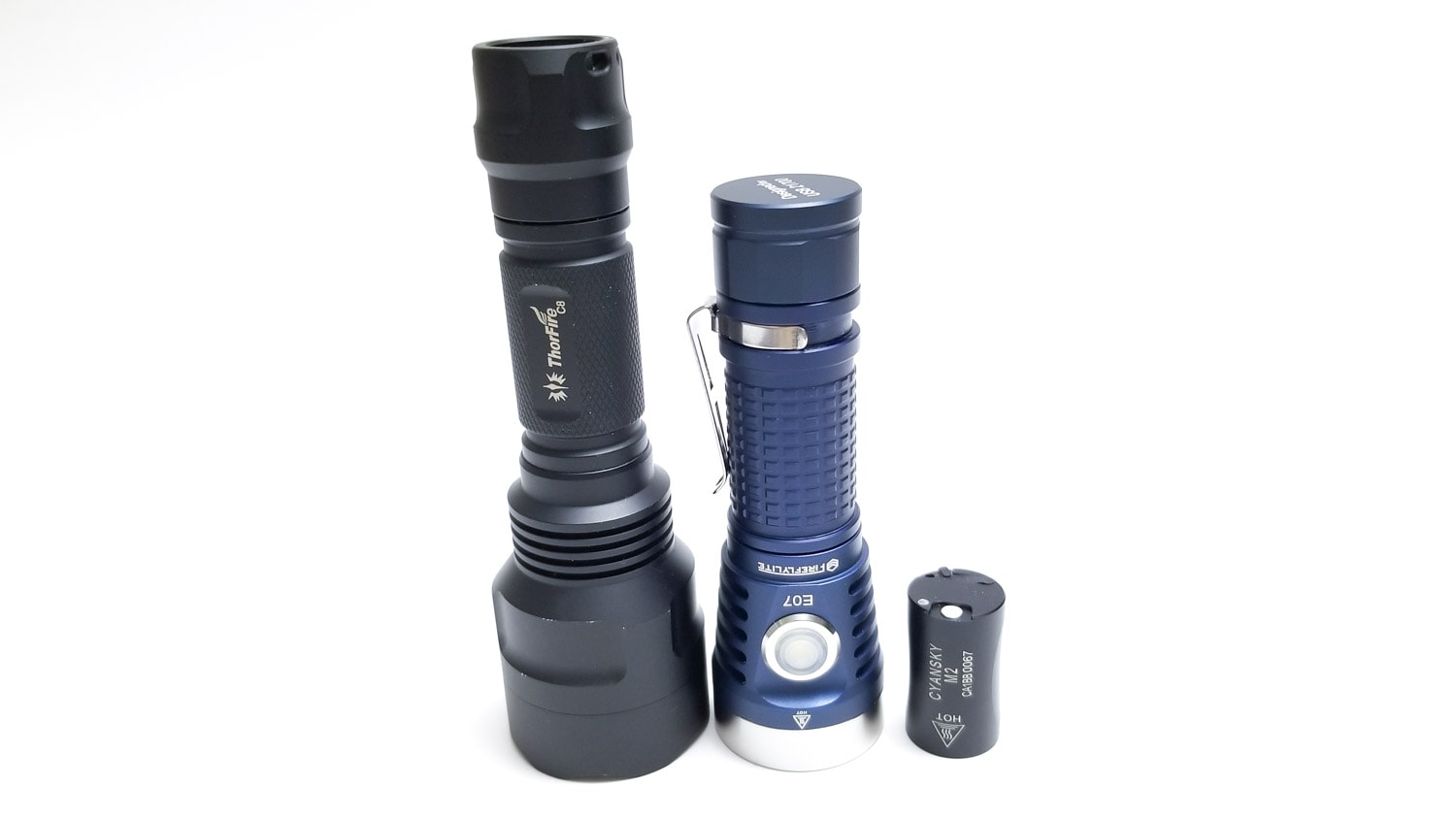
Driver & User Interface:
Although I could get the bezel off, the driver seems glued in and the switch bezel is press fit, so accessing the driver was an endeavor I didn’t want to undertake, but that’s okay because according to FireFlies, the driver is the same FET+3 from the original. This means you get about 1 amp of regulated modes with the FET handling anything higher. Unfortunately, it doesn’t have the superb Loneoceans Lume1 with 6 amps regulated+FET driver found in the E07x (and E12R). Sigh. The UI is also unchanged, so you need to settle for bog standard Anduril. It needs no introduction other than its smooth ramping by default with double-click for Turbo, or stepped ramping for a second user-set mode group and a myriad of configurable parameters for modes, special blinkies, and thermals. All great stuff, but maybe a little daunting for the uninitiated.
Check out the full Anduril UI manual here.
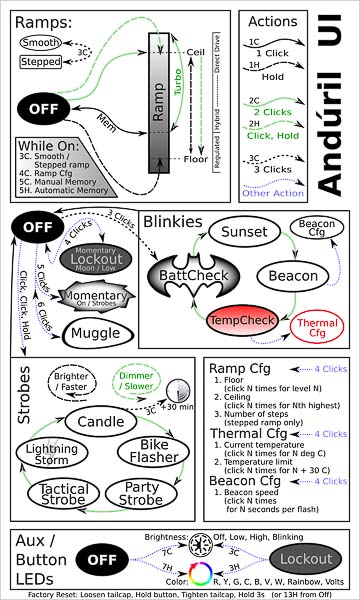
From OFF:
- Single-click: ON
- Double click: High
- 3 clicks: Battery check
- 4 clicks: Lock Out
- 5 clicks: Momentary On
- 6 clicks: Muggle mode
- 7 clicks: Aux configuration mode
Enter Special/Fun modes from OFF:
- 2 clicks + hold: Strobe modes (Click, Click, Click and hold)
- 4 clicks: Lock Out mode (momentary on: dim)
- 5 clicks: momentary mode (Bright) ( you can only deactivate by breaking electrical contact between the batteries and the driver by unscrewing the body from the head.
- 6 clicks: Muggle mode
From ON:
- Single-click: Off
- Double click: Turbo
- 3 clicks: change ramping mode. Instead of a smooth increase, it has 6 little steps between Low and Max.
- 4 clicks: ramping configuration mode (Problematic if you make some changes here by accident)
- Press and hold: brightness ramps up.. release and press and hold again to ramp down.
SPECIAL AND FUN MODES:
Read the full manual on how to access and customize these modes. Also, see the firmware picture.
- Blinky Utility mode:
- Battery check
- Sunset Mode
- Beacon mode
- Temperature check
- Strobe / Mood modes:
- Candle
- Bike flasher
- Party strobe
- Tactical Strobe
- Lightning mode
- Lockout mode (can’t use the light) (activate by 4 clicks)
- Momentary mode (signaling/morse coding)
- Muggle mode: (safer for children)
- Configuration mode
- Ramp config mode
LOCK OUT FEATURE:
- From OFF: 4 clicks. To deactivate click another 4 times.
Additional info: It’s no secret I prefer simpler UIs over Anduril, but this is an enthusiast light so having the added customizability and feature set Anduril gives will appeal to a lot of users. No, it doesn’t have the crazy levels of adjustability of Anduril2, but stock Anduril works great and has a lot of features. Some like that, some don’t. I was expecting the thermal calibration to be off, and it was, but this time it was on the low-end, and cooler than the ambient temperature. I ended up calibrating it to ambient temperature for the tests. FireFlies also sets the default thermal limit to 50 C (instead of 45 C), and I ran into some anomalies with this that I’ll address in the runtime tests. Another added benefit of Anduril here is apparent with the aux LEDs, namely, you can customize them (on or off, blinking, etc.), including the switch LEDs. It also adds infinite brightness adjustment with Anduril’s excellent smooth ramping and the benefit of being able to adjust the thermal limits.
Batteries & Charging
The original FireFlies E07 was designed around a 21700 size li-ion cell, and allowed the use of an 18650 with an adapter. The 2021 Edition ditches the 18650 adapter and introduces the short tube and accompanying oddball 22430 lithium-ion cell. At 22 mm in diameter by 43 mm long, it’s bigger than an 18350 with a little more capacity and about the same current-handling. FireFlies includes a 22430 cell advertised at 10 A discharge and 1850 mAh as part of the short tube option. The smaller cell will work fine, but if you want the most out of the light, the 21700 cell has more capacity and current-handling capability. Flat top 21700’s worked perfectly, but protected cells and button tops were a bit too long, evidenced by the nice big divot in one of my Epoch 50G button tops.
With the E07x on sabbatical with it’s type C onboard charging, Fireflies again had to resort to a hasty compromise. Instead of redesigning the E07’s body and the driver for onboard charging, they went the simple route and included a new tailcap which allows the use of 75 mm+ long 21700s with integrated charging. This was also present with the E07x, but that solution was an insert that replaced the spring and spring PCB. This is only useful if you have cells with integrated charging lying around, and you still need to take out the battery for charging, so again, a bit of a compromise. If you don’t have any 21700s with integrated charging, you still need a standalone 21700 charger. I tried my longest Acebeam 21700 with a charging and protection board, and it fit fine. Note that non-protected button tops still didn’t work with the new tailcap because they were too short and did not make contact.
Pro tip: Any charger that works with a 18350 will work with the 22430 size cell, but keep the charge current at 1-1.5 amps to keep it happy (and living a long time).
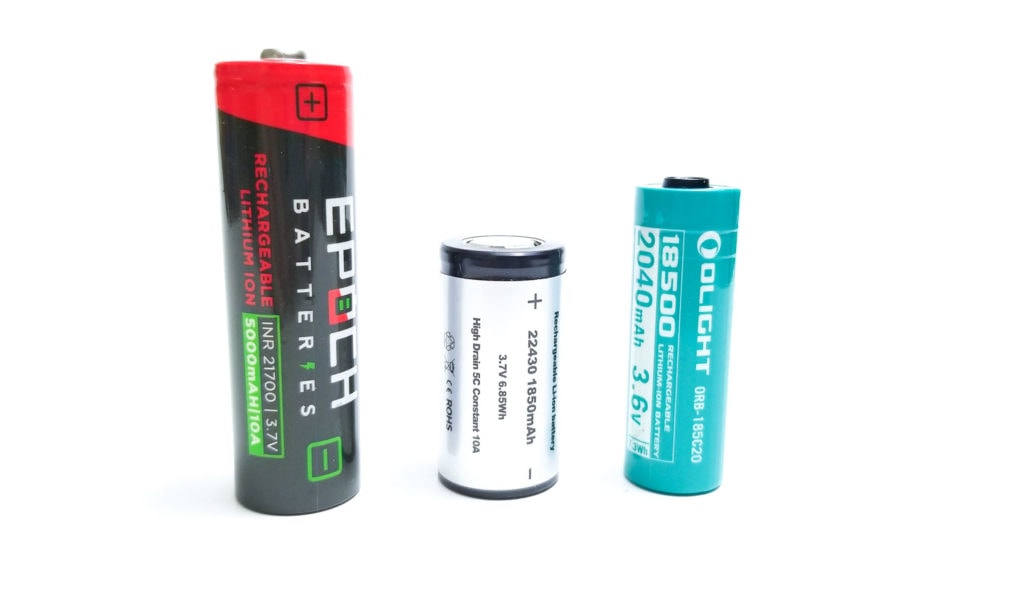
Performance
Like all the Anduril lights, I set the thermal limit to 70 C (maxed out) for the testing to eliminate thermal throttling as a variable for the output. FireFlies does say that they improved the thermal handling of the light, but I’m expecting fast step downs and rapid heating. I did run into a bit of a quandary though, since despite my efforts to prolong the initial step down from Turbo and L7, the light still throttled around 50 C, or 20 degrees C before it should have. Hmmm.
Runtime graph
I conducted the runtime test using the 30 centimeter integrating sphere with the Digi-Sense 20250-00 data logging lux meter. I used the fully charged Molicel P42A (my Epoch 50Gs don’t fit) and tested stepped modes L5-L7 and Turbo. L5 should be the highest regulated mode, so we should see nice consistent output from it.
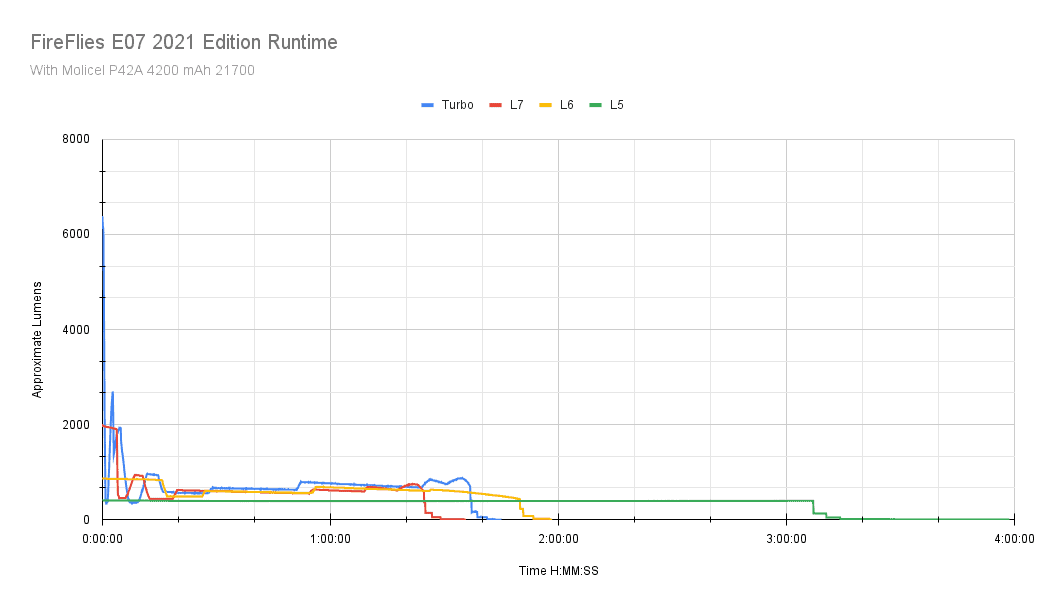

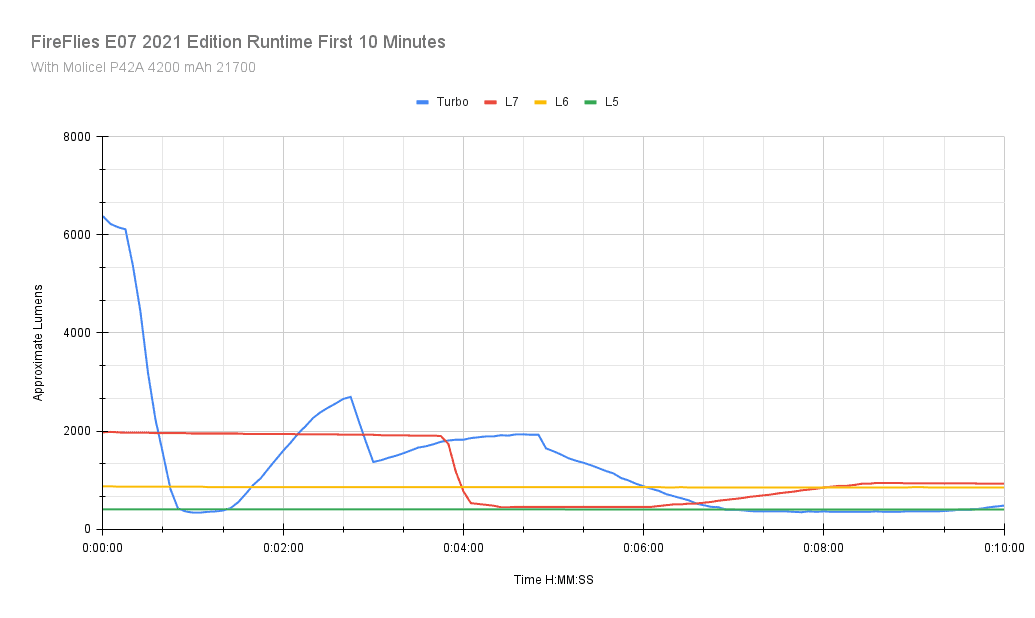
Turbo started at 6384 Lumens, which is higher than 6200 FireFlies advertised for this particular XP-L HI. This is still an impressive output though. As expected, it heated fast, up to 30.8 C from 24 ambient in 5 seconds, 40.2 C within 10 seconds. However, the output unexpectedly started ramping down by 15 seconds and 46 C on the temp gun. Hmmm. I had set the thermal limit to 70 C, but maybe FireFlies did some kind of magic in the firmware to limit the Turbo step down to 15 seconds or 50 C (whichever comes first). This was indicated on the website, but I didn’t think it would override a user-set calibration. By the 1 minute mark, the output ramps back up at 48 C, and by 2 minutes, the head is properly hot at 65 C, and 30 seconds later, hits 70 C as it should. The temperature regulation worked fine, adjusting the output to 2478 Lumens by 2 minutes 30 seconds, then back down to 1396.2 Lumens by 3 minutes. This behavior continued for the next hour, but leveled off between 550 and 850 Lumens, never exceeding 850 Lumens until the LVP cuts in 1 hour 38 minutes down to 50.4 Lumens, then down to 8.4 Lumens 2 minutes later. I ended the test a minute later since Anduril will run at this extremely low output for hours and hours. Total time 1 hour 43 minutes 10 seconds.
Level 7 started at 1974 Lumens, and held about 1900 Lumens for over 3 minutes, which is pretty impressive, gradually stepping way down to 450 by 4 minutes, and throttling up again to about 1000 Lumens by 9 minutes in. The throttling continued to adjust the output between 800 and 550 Lumens for the next hour and 20 minutes, until LVP pulled the plug and dropped the output to 140 Lumens, then down to 50.4 Lumens like Turbo, and finally down to 8.4 Lumens when I ended the test at 1 hour 35 minutes. Unlike Turbo, the light hit the thermal limit with none of the premature throttling. Max temp was 72 C recorded at 4 minutes in. Runtime was less than Turbo, but I suspect this is because it held higher output longer in the first part of the test.
Level 6 started at 873 Lumens and was much more consistent with regulating the output, without huge swings in output as the light heated and cooled. It held 800 or more Lumens for an impressive 15 minutes 50 seconds, before throttling down to 487 Lumens. The output adjusted between 440 and 680 Lumens for the next hour and 20 minutes. Max temp was 64 C peaking by 10 minutes, but was hand-friendly for about 8 minutes. By 1 hour 50 minutes, the output was down to 75 Lumens, then way down to under 20 Lumens 3 minutes later. I ended the test 4 minutes later at 1 hour 57 minutes and 45 seconds.
Level 5 was pretty uneventful and shows we’re in a fully regulated mode with a nice, flat output graph. The test started at 402.3 Lumens, and held that for 3 minutes 33 seconds, before an imperceptible step down to 399 Lumens, and after that, it was rock-solid, holding 390+ Lumens for nearly 3 hours. There was an LVP step down to 131 Lumens at 3 hours 7 minutes, and 3 minutes later, down to 40 Lumens. LVP really kicked it by 3 hours 29 minutes down to about 2 Lumens, and I ended the test 22 minutes later at 3 hours 57 minutes. Temps never exceeded 48 C, so the light was hand-friendly the entire runtime.
This is typical FET driver with Anduril driver behavior, and except for FireFlies manipulation of the thermal regulation algorithm on Turbo, the E07 performs as expected. I even tried recalibrating the thermal limit 3 times to no avail. Although FireFlies could have done away with that premature throttling on Turbo, it only would have afforded about 30 extra seconds of output before it started throttling back. Although I prefer a boost or buck driver in high output lights, I get it that those parts can be expensive (or as hard to find as Jimmy Hoffa currently) so an FET+3 is the way to go. This is still acceptable performance, and you can always tune the thermal limit to your liking for longer sustained output. I think about 500-600 Lumens is about all this light can reliably sustain for bare-hand use.
Lumen measurements (for each mode)
For the lumen tests, I used my home made 30 cm integrating sphere calibrated with lights of known output using the Digi-Sense 20250-00 data logging lux meter. Amps were measured with my Radio Shack TRMS multimeter with short 16 gauge wires inserted in the meter for currents under 5 amps, and my FY219 clamp meter and a 12 gauge wire loop for over 5 amps. I tested stepped levels 1-7 plus Turbo and used a Samsung 30T to give a good benchmark of the light’s potential. I tried the 22430 cell, and the readings were similar to the 30T until the FET took over. Level 7 was 5.68 A and Turbo hit 17.68 A at start.
FireFlies doesn’t list Lumen specs other than 6200 for the V2 5A XP-L HI emitters. A firefly (depending on which of the 170 species you sample) makes around 0.025 Lumens.
| Mode | Amps at Start | Specs | start | 30 seconds | 10min |
|---|---|---|---|---|---|
| 1 | 4 mA | ? | 0.84 | 0.84 | – |
| 2 | 27 mA | ? | 6.72 | 6.72 | – |
| 3 | 140 mA | ? | 30 | 57.9 | – |
| 4 | 400 mA | ? | 169 | 168.8 | – |
| 5 | 1.04 A | ? | 402 | 404.88 | 399 |
| 6 | 2.28 A | ? | 874 | 865.2 | 848 |
| 7 | 6.5 A | ? | 1974 | 1965.6 | 924 |
| Turbo | 25.6 A | 6,200 lm | 6,384 lm (6,640 on 30T) | 3192 | 789 |
Parasitic drain:
2 mA with the aux LEDs on maximum, and 10 microamps with them off.
Throw numbers:
Throw was measured at 5 meters indoors using the Uni-t UT383S lux meter. I used a Samsung 30T 21700 battery for all tests. Readings taken at 30 seconds. FireFlies doesn’t list throw or candela specs, save for 25,000 cd for all of the XP-L variants.
| Mode | Specs | Candela Measured | Meters |
|---|---|---|---|
| 1 | ? | N/A | N/A |
| 2 | ? | N/A | N/A |
| 3 | ? | 225 cd | 30 |
| 4 | ? | 750 cd | 54.77 |
| 5 | ? | 1850 cd | 86.02 |
| 6 | ? | 4025 cd | 126.88 |
| 7 | ? | 9025 cd | 190 |
| Turbo | 25,000 cd | 10,875 cd | 208.56 |
| Turbo at start | – | 24,800 cd | 314.96 |
On Turbo at startup, I got very close to FireFlies advertised specs for candela, so that’s nice. However, due to the rapid step down on Turbo after 15 seconds, the candela has gone way down by the 30 second mark. This is mostly a flooder so the throw isn’t that great, but still good enough for most applications. If you want more throw, opt for the OSRAM emitters.
Beamshots
I compared the E07 2021 Edition to some similarly high-powered, multi-emitter flashlights. The E07 has a great overall beam profile and even though I prefer cooler CCTs, it’s nice to look at and less harsh on the eyes. The throw is good, but not great. I think the 10 degree optic from the E07x would be a better fit here. Obviously, this is more of a flooder than anything else, but still a nice balance.
- Outdoor shots: The fence is about 95 meters away. Compared to the Imalent R30C (3x SST70 9000 Lumens-advertised), Astrolux FT02S (4x XHP50.2 12,000 Lumens), Astrolux EC03 (3x SST40 5100 Lumens), Wurkkos DL70 (4x XHP50.2 13,000 Lumens), WildTrail WT3M (3x XHP50.2, 6800 Lumens), Nightwatch NI03 (SFN55.2 7800 Lumens), and Thrunite TC20 V2 (1x XHP70.2 4068 Lumens).
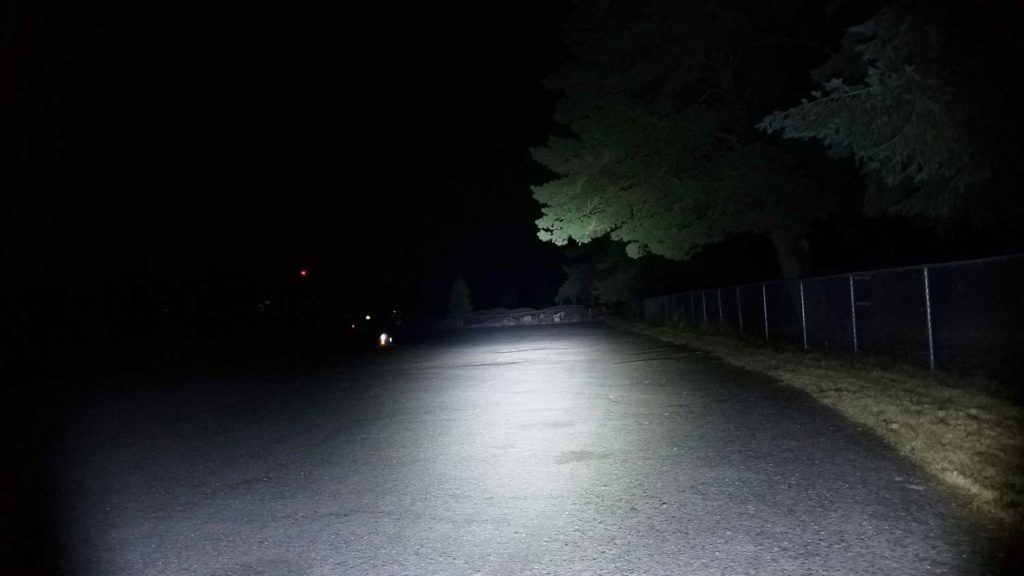
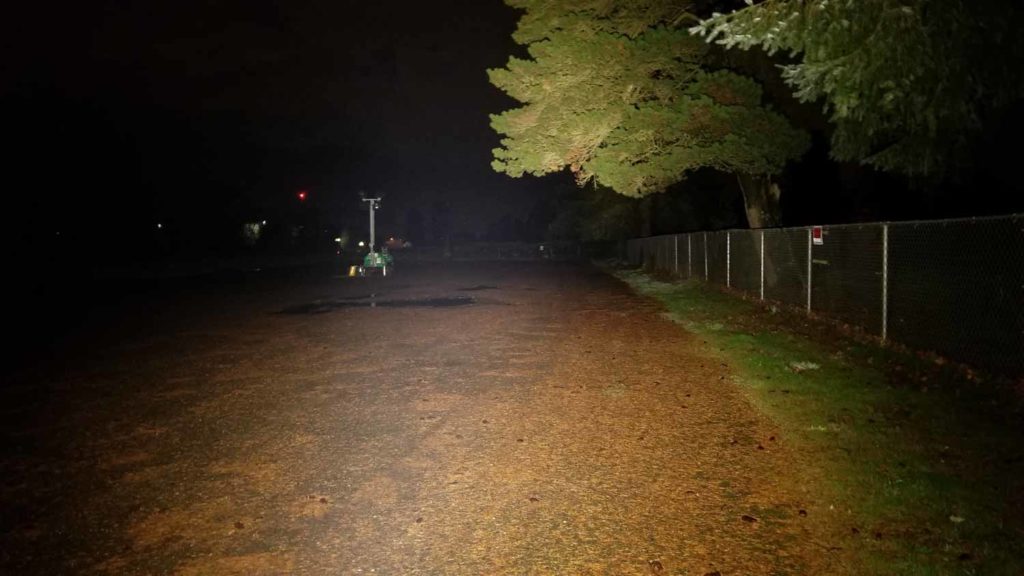
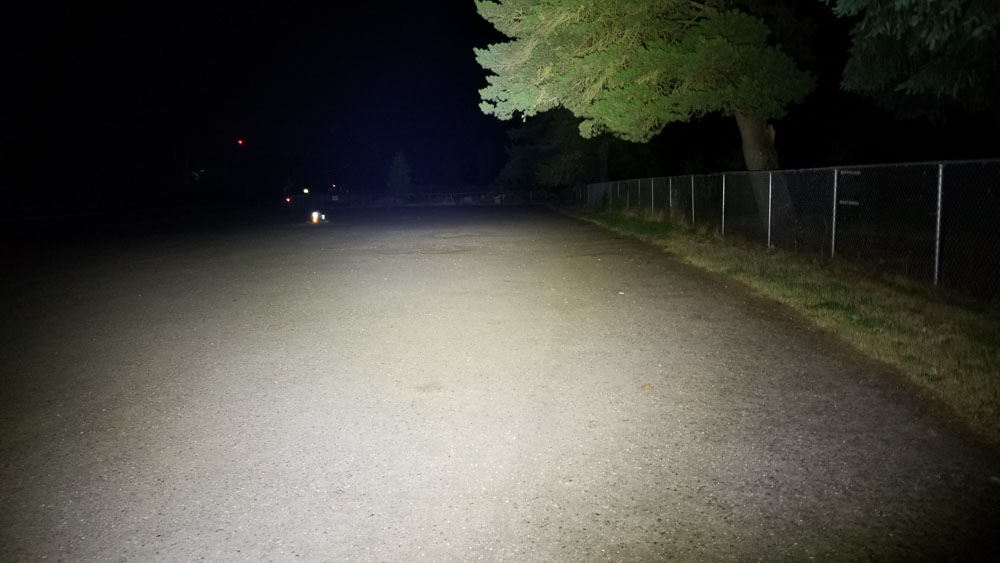
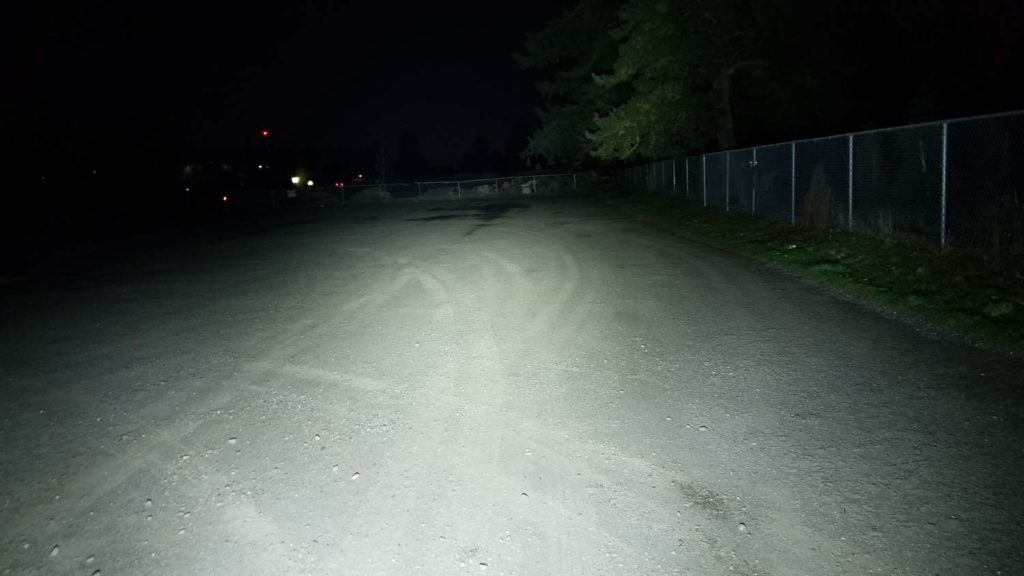
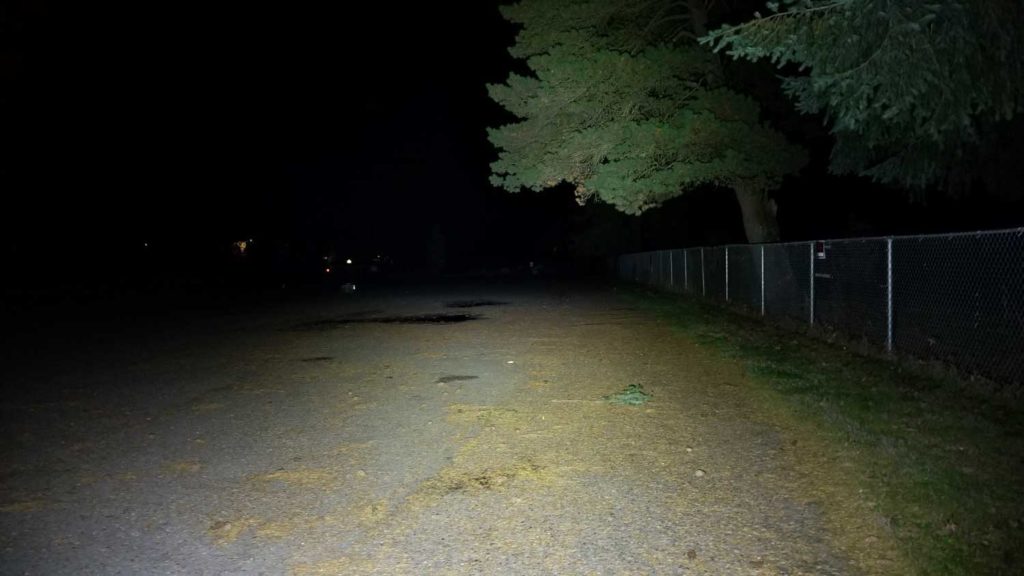
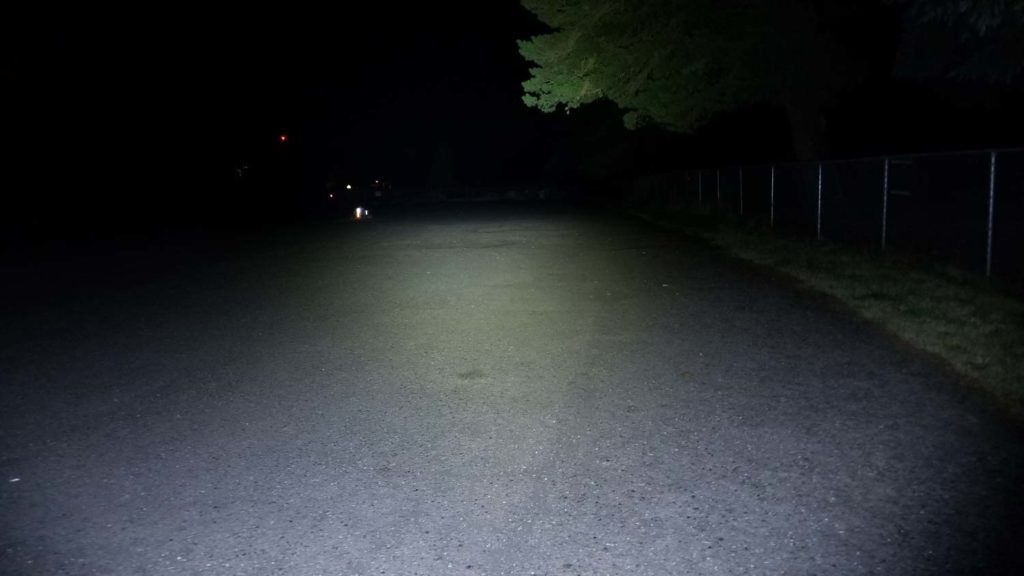
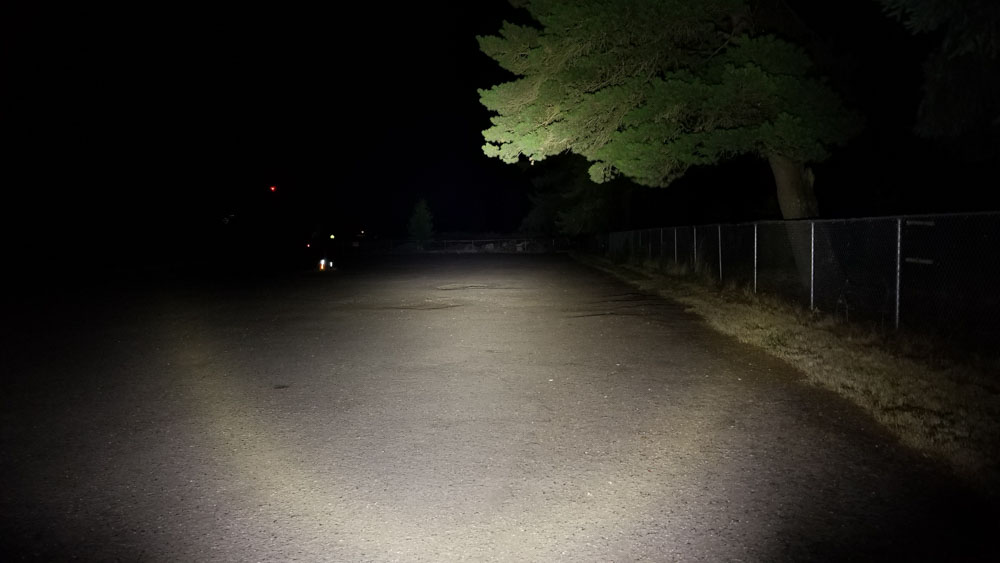

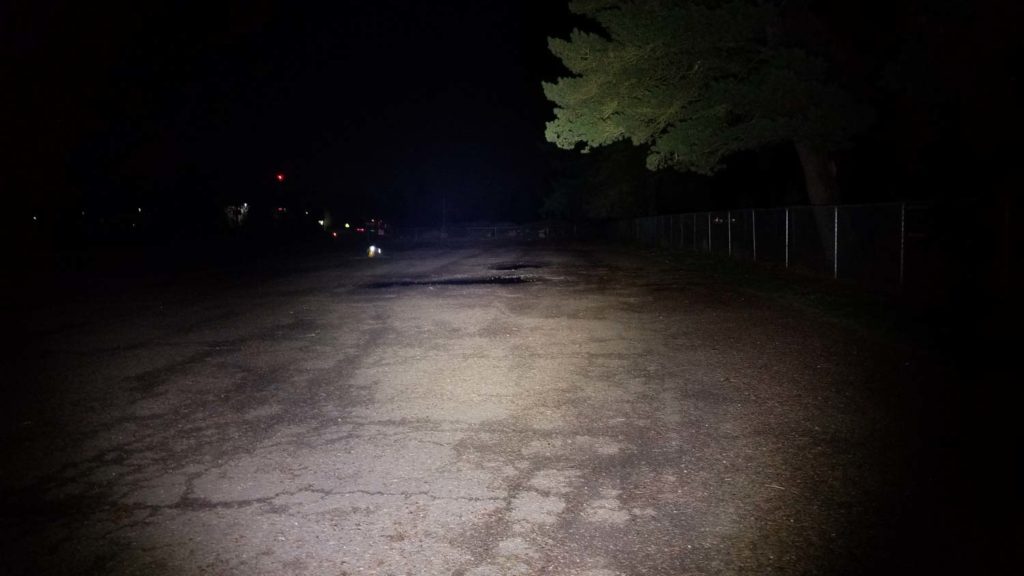
Disclaimer: This flashlight was sent to me for review at no cost by FireFlies. I have not been paid to review, nor have I been holding back on problems or defects.
Final Verdict
Pros
- Great design and good fit and finish
- Anduril UI
- Lots of emitter choices
- Lightweight
- Cool aux emitters and lighted switch
- Versatile beam
- Great output
- Strong magnetic tailcap
Cons
- Fast step down on Turbo couldn’t be changed by increasing the thermal limit
- Included lanyard is cheap
- Short tube doesn’t work with pocket clip
- Anduril UI can be complicated
- Tailcap color was off
- Some button tops might not fit
Explanation on star ratings:
1: Avoid: my phone flashlight would be a better choice – 2: Poor: significant defect or issues; almost unusable – 3: Average: some defects or issues; but still usable 4: Good: recommended (minor issues) – 5: Great: highly recommended

4 stars: ★★★★
The E07 has been around for almost 3 years, and even with the random quality control issues, it has been a big seller. With the E07x missing from the product lineup, the elder statesman E07 is being asked to fill some big shoes, and unfortunately in a world of lights with onboard USB charging, support for protected 21700s, and buck/boost drivers, the aging E07 wasn’t going to win any brownie points with enthusiasts eager to get the much improved ‘X’ model. That said, the question I’m sure everyone is asking by now is have the updates made it a viable alternative? The short answer is yes and no. Yes, in that the 22430 tube and the revised tailcap for 21700s with charging and revised optic are welcome features. However, at the end of the day if you strip those away, you’re still left with an E07 from 2019-2020. Yep, same driver, same emitters, same externals, same construction.
What do I like about the FireFlies E07 2021? I love the form factor, design, handling, and the performance is pretty amazing for an EDC size light. I also appreciate the nod towards enthusiasts with the myriad of emitter choices and configurability afforded by Anduril. You can customize this light quite a bit, and since you can remove the bezel and MCPCB, emitter swaps are possible. It’s also a decent value in stock configuration. I like the improvements to the fit and finish as well. Now, I don’t care for the very fast step down on Turbo even when I adjusted the limit to 70 C. It would be nice to have a pocket clip for the 22430 tube, and the junky lanyard is out of place here. The off-color tailcap was a major drag as well. Furthermore, if adding optional emitters, special tailcap, and short tube with 22430 battery, the E07 2021 Edition is pretty much the same price as the base E07x, and therein lies the conundrum: Unless you must have the Cree or OSRAM emitters with your E07, my advice is to wait for the E07x to come back around with the far superior driver, onboard charging, better optic, improved heat sinking, and Anduril2…or just get both. Either way, 4 stars for the FireFlies E07 2021 Edition.
FireFlies E07 2021 version for sale here:
The FireFly E07 has been replaced by the FireFlyLite E07X and E07X Pro. Check out the following lists instead:
1lumen selects and reviews products personally. We may earn affiliate commissions through our links, which help support our testing.